


- Introduction
- Fundamentalists, Progressives & Moderates
- Did Jesus marry Mary Magdalene?
- The Jesus of Faith vs the Historical Jesus
- Do we have the actual words of Jesus?
- Has God inspired every dot and comma in the Bible?
- Can you be a Buddhist & a Christian?
- Was St Paul a misogynist?
- What is a fundamentalist?
- Eschatology & The End of Time





- Introduction
- Fundamentalists, Progressives & Moderates
- Did Jesus marry Mary Magdalene?
- The Jesus of Faith vs the Historical Jesus
- Do we have the actual words of Jesus?
- Has God inspired every dot and comma in the Bible?
- Can you be a Buddhist & a Christian?
- Was St Paul a misogynist?
- What is a fundamentalist?
- Eschatology & The End of Time








Photometry of Asteroids
I have always been attracted to the possibility of doing worthwhile science whilst engaging in my hobby. In 2001 and 2002, I discovered three previously unknown asteroids which have since been numbered, 124033 (2001 FP127), 112835 (2002 QL17), and 191213 (2002 RA01). At a workshop in Australia in 2003 which brought together amateur and professional astronomers, it was pointed out that while discovering a new object in space is always exciting, amateurs could contribute more worthwhile science if they engaged in photometry of asteroids. In astronomy, photometry is the measurement of light emitted by, or reflected by, a celestial object. Stars emit light of their own; asteroids reflect light from the Sun. Between the orbit of Mars and the orbit of Jupiter there is a huge gap. Many believed that a planet remained to be found somewhere in that gap. On the 1st of January, 1801, a Catholic priest, astronomer and mathematician by the name of Guiseppe Piazzi, discovered a celestial body in this gap. He called it “Ceres” after the Roman goddess of grain. Following Piazzi’s discovery, other bodies were discovered in this space between Mars and Jupiter, though Ceres would remain the largest. The illustration on the left comes from N.A.S.A. It shows the wide range of sizes of a number of asteroids in the space between Mars and Jupiter. This space is now known as the “Main Belt” of asteroids. Ceres went through a number of classifications. At first described as a “planet”, it would be categorised as the largest “minor planet”, and nowadays, as a “dwarf planet”. Throughout all these re- classifications, the term “asteroid”, meaning “star-like”, has served as a collective term that includes them all. Because of its relatively large size, Ceres’ own gravity has moulded it into a spherical shape. The next largest asteroid, Vesta, is also slightly spherical; but after that the bodies orbiting in this Main Belt are typically irregular in shape. The irregular shape of these bodies actually provides us with a helpful quality to research them further. Many of these bodies are tumbling as a result of collisions between themselves. As they tumble, they may present themselves to us on Earth first broadside, then end on. The sunlight they reflect thus rises and falls twice with each rotation. The speed of rotation gives a hint about their composition, as fast rotators must be made of iron in order to withstand the centrifugal force of their rotation. Information about composition may be important if we ever have to deflect an asteroid on a collision course with the Earth. Of course, through any telescope on Earth, asteroids do not appear as in the animated illustration above. They appear only as points of light which move against the background of stars. The stars are much further away, and like the horizon from a moving train, appear to be motionless. Asteroids are part of our Solar System and thus much closer. Their motion is readily apparent when photos, say 15 minutes apart, are combined. The animated photo adjacent from NASA is created by combining several frames separated by time. Although the asteroid cannot be seen rotating in such photos, measurement of the light reflected by the asteroid rises and falls in a “lightcurve” that can be represented on a graph. If the asteroid is a fast rotator, a full lightcurve can be established in a relatively short period of time. However, if the asteroid is a slow rotator, the length in time of the full curve may exceed the hours of darkness available to the astronomer. This gives rise to collaborations between astronomers scattered around the world in a kind of relay. My first collaboration took place in July, 2005, in response to a request for photometry of the asteroid 1992 UY4 by Dr Lance Benner of NASA/JPL. Dr Benner was leading a group of radio astronomers who were turning their attention to the asteroid. Some radio telescopes, which normally only receive data, are also used to transmit radar wavelengths. The radar signals are bounced off objects like asteroids to gather more information on the target. However, astronomers using radar sometimes need information on rotation rates derived from optical observations in order to set parameters for their radar signals. Those collaborating in support of Dr Benner’s request included observers in the U.S.A., Brazil, Spain, Switzerland, and myself in Australia. Our combined data was used to develop a lightcurve seen below. As reported in the Minor Planet Bulletin (Vol. 33/1), “In early August, Dr. Benner reported his group had successfully observed 1992 UY4 and that the efforts of this collaboration had proven invaluable in making that possible.” I will post any future asteroid photometry on this website after it has been published in the Minor Planet Bulletin . I am not sure I want to go to the trouble of posting past photometry of asteroids on this website as it does not seem like a good use of time.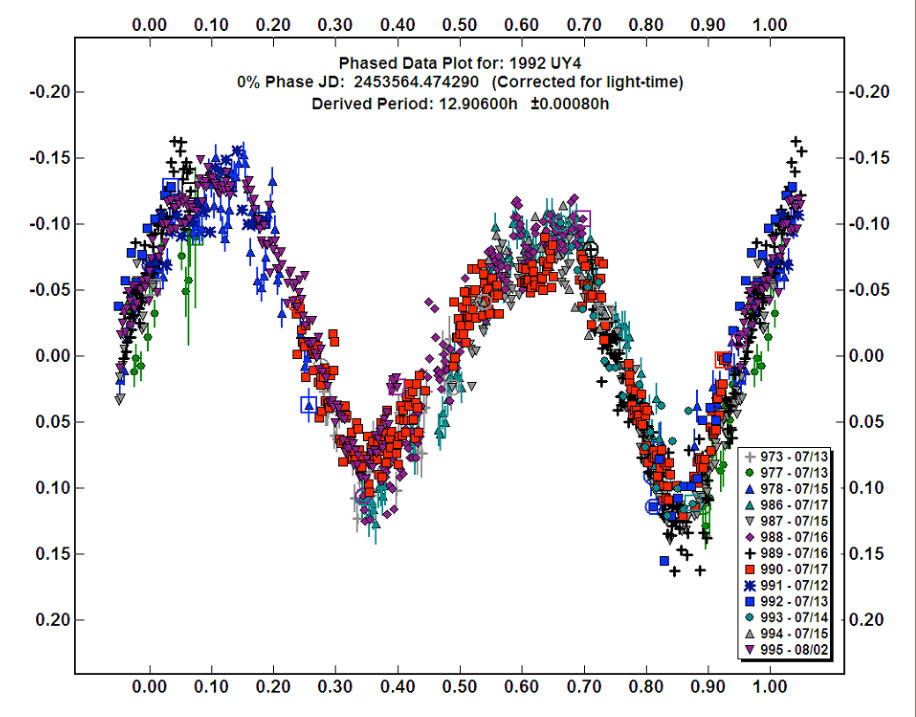
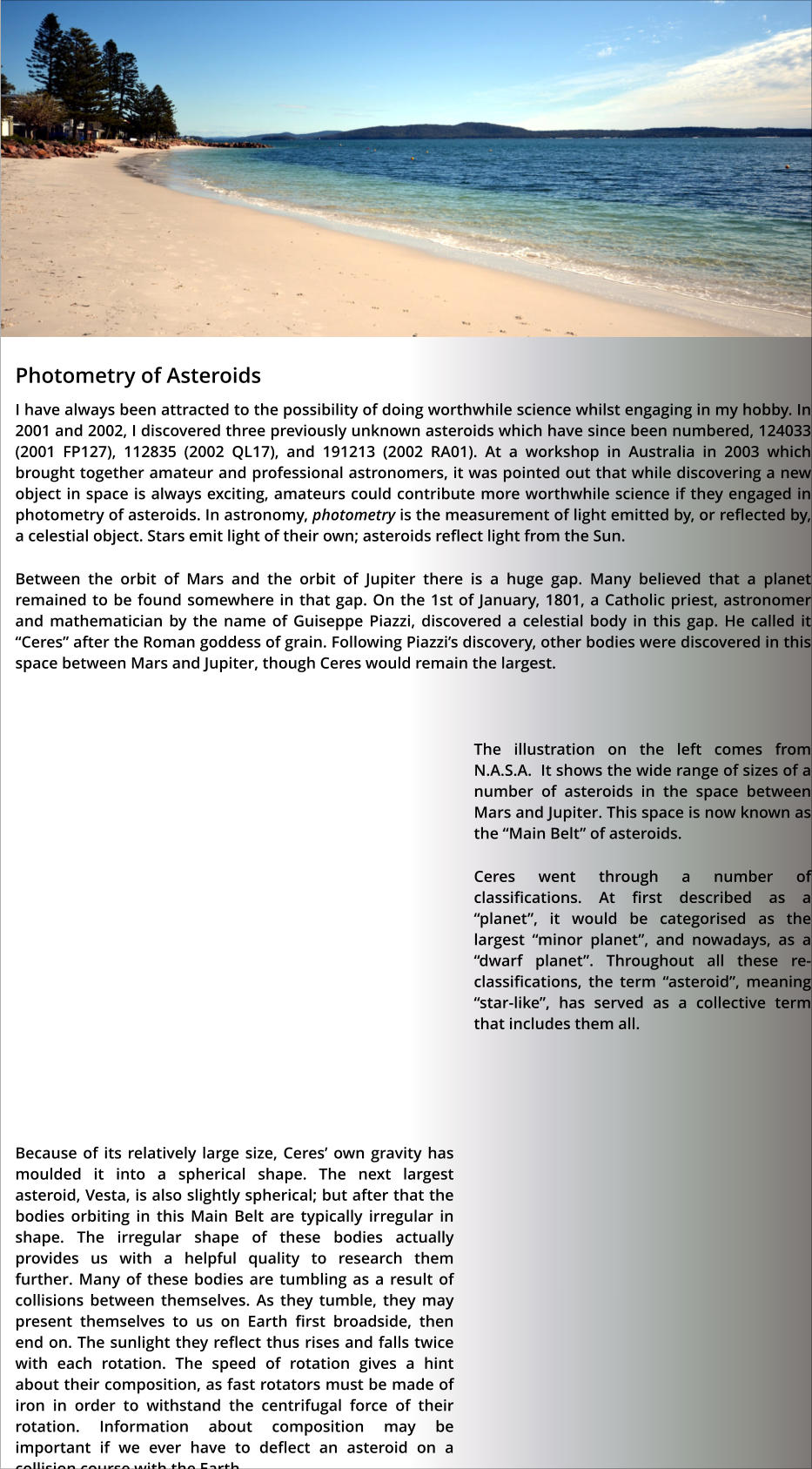


- Introduction
- Fundamentalists, Progressives & Moderates
- Did Jesus marry Mary Magdalene?
- The Jesus of Faith vs the Historical Jesus
- Do we have the actual words of Jesus?
- Has God inspired every dot and comma in the Bible?
- Can you be a Buddhist & a Christian?
- Was St Paul a misogynist?
- What is a fundamentalist?
- Eschatology & The End of Time









Photometry of Variable Stars - Introduction
There are many varieties of variable stars. In fact, a listing of the various types is mind-boggling. Consequently, this introduction will focus on only one type which I intend to pursue, namely, eclipsing binary pairs. These pairs consist of two stars orbiting around their common centre of gravity. Usually one star is smaller in dimensions than the other; but the smaller star is nevertheless denser, and thus more massive than the larger star. To understand that notion, consider and compare a cannon ball with a balloon. Such is the distance of all stars from the Earth, (with the exception of the Sun), that they only appear as pinpoints of light. They cannot be resolved by the optics of our telescopes into discs. The disc shape of stars in our photographs arises from the pinpoint of light wandering about on the imaging chip due to atmospheric fluctuations and tiny mechanical imperfections in the telescope mount over the course of a time exposure. Consequently, a pair of eclipsing binary stars appears as one single pinpoint of light. How then do we know that this single pinpoint of light is actually a binary pair? The answer is some detective work! A light-curve is a graph of the amount of light coming from a celestial object, and when the orbital plane of the binary pair is so aligned with respect to the Earth that the stars take it in turn to eclipse each other, the light-curve shows the tell-tale signs. The animated graphic which follows makes this easier to understand. A graph below the stars shows how the orbital motion translates into a light-curve. When a sequence of photographs of an eclipsing binary pair is taken over a period of some hours, it usually reveals the telltale shape of an eclipsing binary light-curve. As the binary pair continue to orbit around their common centre of gravity, the light-curve is repeated over and over. Such repeated light- curves can be overlaid each other to get a more accurate measurement of their cycle. Let’s jump ahead, with a light-curve from a later page in the website, of the eclipsing binary stars V0676 Cen. You will notice the characteristic “M” shape of the curve, and the fact that the minimum point in the middle does not dive down as far as the minimum points on either side. This fact points to the unequal spatial dimensions of the two stars. Bear in mind that through this process we have concluded that just a single point of light in the night sky is actually a pair of stars orbiting around their common centre of gravity; and that the stars are of unequal size and mass. But wait! There’s more! The gravitational fields around these two stars interact in a very interesting way. Very close to the surface of each star the gravitational field looks very much like any single star. But as one moves away from the surface, the gravitational fields of each star begin to interact. The result is illustrated by the following graphic. The gravitational fields around the binary pair are known as Roche lobes. The point marked L1 in the diagram is known as the primary Lagrangian point. The smaller star in terms of dimensions is nevertheless the star with the greatest mass. It is possible for the smaller star to rip off gas from the larger star, and when this happens the mass usually flows through the primary Lagrangian point. Of course, the illustration above is two dimensional. In reality, the gravitational fields are three dimensional and the gravtational fields are more in the shape of an hour glass.


- Introduction
- Fundamentalists, Progressives & Moderates
- Did Jesus marry Mary Magdalene?
- The Jesus of Faith vs the Historical Jesus
- Do we have the actual words of Jesus?
- Has God inspired every dot and comma in the Bible?
- Can you be a Buddhist & a Christian?
- Was St Paul a misogynist?
- What is a fundamentalist?
- Eschatology & The End of Time


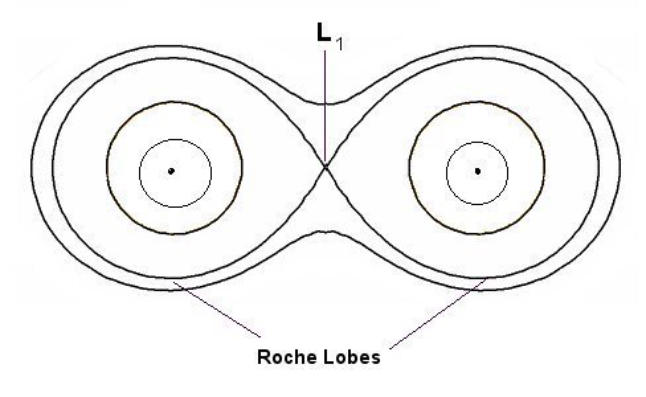
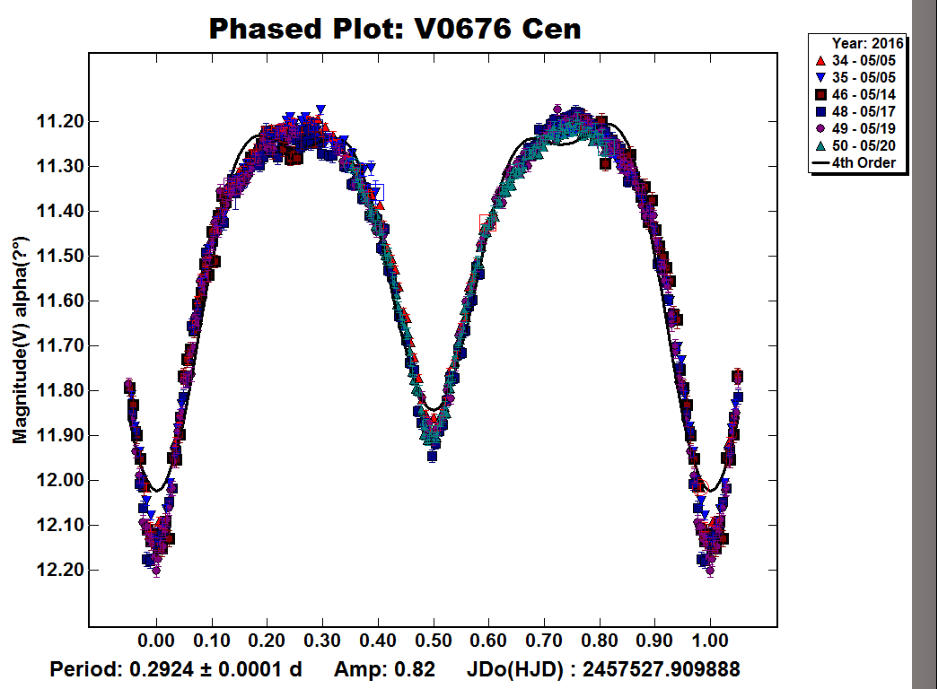






- Introduction
- Fundamentalists, Progressives & Moderates
- Did Jesus marry Mary Magdalene?
- The Jesus of Faith vs the Historical Jesus
- Do we have the actual words of Jesus?
- Has God inspired every dot and comma in the Bible?
- Can you be a Buddhist & a Christian?
- Was St Paul a misogynist?
- What is a fundamentalist?
- Eschatology & The End of Time

V0676 Centaurus
All of the variable stars being targeted by the group I belong to are in the southern hemisphere. This is because most professional and amateur astronomers are located in the northern hemisphere and are unable to view these stars. In consequence, southern hemisphere variable stars are often neglected. This program aims to overcome that neglect. Lately I have been targeting eclipsing binary stars in the constellation of Centaurus. This page in the website is given over to V0676 Centaurus, which is usually abbreviated as V0676 Cen. Information of interest is found by determining the shape of the lightcurve, and from the ‘signature’ of the lightcurve, the nature of the binary pair. Is one star larger than the other? How far apart are they in their orbits? Are their orbits as regular as clockwork giving an unchanging period? Is there any exchange of mass between one star and the other? Initially the period of the lightcurve may, or may not, be known. So one of the first tasks is to observe the star over sufficient time to determine its period and the times of ‘minima’ where the eclipse reaches its extreme point. Here is a plot of the lightcurve of V0676 Cen over one night - this is a ‘raw’ curve: Note that, in this section of the curve, the minima are unequal. One star of the binary pair is eclipsing the other more completely, so that the light travelling to us is dimming more on this occasion than when it is the other way around. Note also that there are gaps in the lightcurve which may affect the accuracy of the calculations. Sometimes this is because the hours of darkness available to the astronomer make it not possible to cover the entire curve. (Hours of darkness available to the astronomer are longer in winter than in summer.) Another cause, and the one with the major impact on this data, is that technical problems occur which bring a halt to data-gathering. This is pretty frustrating for the astronomer, but there are typical causes for these problems. Many amateur astronomers mount their telescopes on what is called a German Equatorial mount. Here is an illustration of that kind of mount: On the left is a snapshot of a German Equatorial mount which has been tracking a star as it rises in the east. One of the axes of the telescope mount is aligned so that it is parallel with the Earth’s rotational axis. (This is the Right Ascension axis). As the Earth rolls on its axis toward the east, the telescope mount is able to track the star by rolling towards the west. However, as the star approaches the meridian straight above, the telescope is unable to track it any further, because the ‘science’ end of the telescope would run into the pier supporting the telescope mount. At this point, the telescope must do a ‘meridian flip’, which involves the scope rolling over to the east and then doing a 180 degree turn on its declination axis. The result of this flip is that the image focused onto the camera chip is rotated 180 degrees as well. This can make processing of the night’s sequential images of the target difficult. It also adds complication to the task of tracking the star. When the telescope is locked onto a target, the motors driving the telescope around the Right Ascension axis have their speed set to match the rotation of the Earth. However, the slightest imperfections of the gearing results in varying rotational speed. To overcome this, a second imaging chip is often used to monitor any movement of the star focused onto the chip. As soon as movement is detected, the guide chip sends corrections to a prism in front of the chip so that tiny corrections to alignment can be made. If the movement exceeds a certain amount, corrections are then sent to the motors. The picture on the right shows the “field of view indicator” for an astronomical camera with both an imaging and a guide chip. The target is shown as a star circled in yellow and the larger rectangle represents the field of view of the imaging chip. The smaller rectangle represents the field of view of the guide chip. The star within that field of view is the guide star. The guide chip locks onto a star just outside of the area of interest, but fairly close. The circles encompassing the guide chip show where the guide chip would be if the camera was rotated. The 180 degree rotation caused by a meridian flip would mean that there is no guide star to lock onto! One way around this problem is to place a “rotator” in the optical train and rotate the camera 180 degrees after a meridian flip. This process takes time, and in addition, there may be a “dead zone” in the telescope’s ability to point at the meridian from either side. It may also be necessary to refocus around this time as the telescope cools and changes the focal length inadvertently. Software can assist by automatically refocusing the star, but some focusing software is more equal than others. All these delays can lead to a gap in the data and thus a gap in the plotted lightcurve. Don’t go into this hobby if you don’t have good tolerance for frustration! One answer to these problems is to go back night after night and get more lightcurves of the same object. Then, instead of plotting the lightcurve as “raw” data separated by days at a time, see if you can “phase” the data, by identifying where a lightcurve is being repeated over and over. This is what has been done in the following graph. It’s a bit messy in places, but remember, this is the real world. So there you have it. My work on this eclipsing binary pair to date.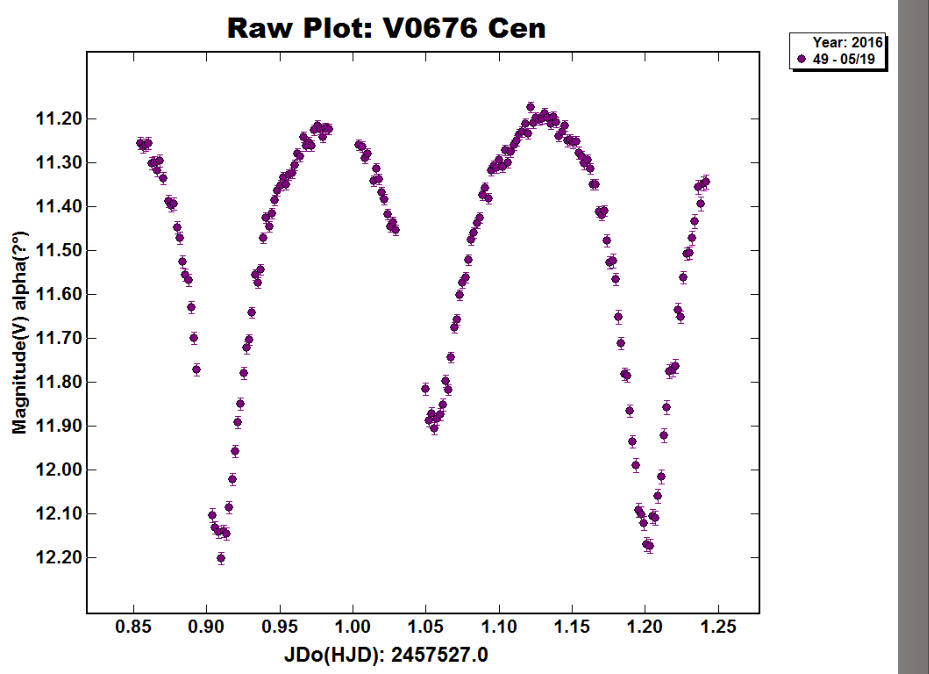









- Introduction
- Fundamentalists, Progressives & Moderates
- Did Jesus marry Mary Magdalene?
- The Jesus of Faith vs the Historical Jesus
- Do we have the actual words of Jesus?
- Has God inspired every dot and comma in the Bible?
- Can you be a Buddhist & a Christian?
- Was St Paul a misogynist?
- What is a fundamentalist?
- Eschatology & The End of Time

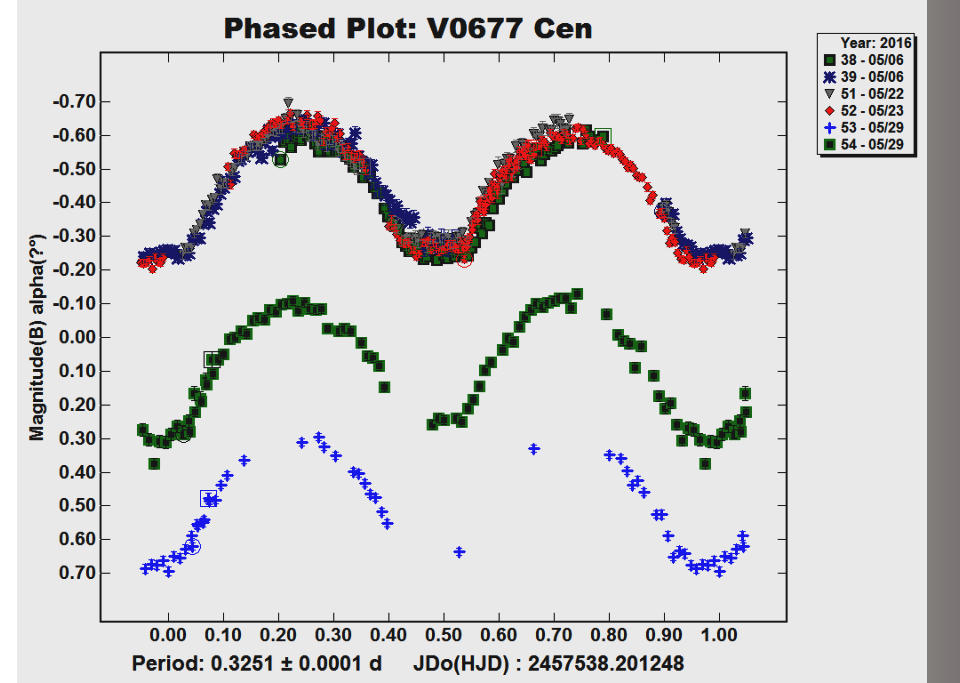
V0677 Centaurus
It seems I am working my way through eclipsing binaries found in the constellation of Centaurus. This is not totally by accident. The Earth not only rotates on its axis, it is also moving along in its orbit around the Sun. The result is that particular stars rise earlier and earlier each night so that some are already high in the sky by the time that darkness falls and there are fewer hours of darkness left before they set. Since the aim is to get as much of the lightcurve as possible, it is necessary to move along to new targets after a few weeks or months. At the moment I am trying to get another eclispsing variable in the constellation of Centaurus before it becomes too late. V0676 Cen is followed by V0677 Cen in the General Catalogue of Variable Stars (GCVS). If the previous target pages have seemed to have followed a simple, logical pattern, then it’s time to welcome chaos. The measurement of a star’s magnitude depends on a simple linear relationship between the amount of light that falls on the imaging chip and the camera’s registration of intensity. Put simply, in a linear relationship, each unit of light falling upon the imaging chip leads to a proportional increase in signal registered by the chip. However, beyond a certain range, this linear relationship can fall apart and the pixels on the imaging chip are said to be “saturated”. The problem with initial attempts at recording a light curve is that one does not know how the brightness of the star at its peak of variability will affect the camera. The longer the exposure, the more likely the camera will go beyond linearity. At the other extreme, a shorter exposure may be too short to achieve sufficient signal-to-noise ratio (SNR) and one will be left trying to measure the star’s magnitude when the impression it leaves on the imaging chip is barely above the random fluctuations of signal in the chip itself caused by heat in the ambient temperature. Thus the other night my attempt to get better SNR on V0677 Cen seemed OK at first, but later into the night V0677 started to saturate my camera. Observations of variable stars are usually taken through specific filters designed for scientific use, and traditionally these have been the Johnson-Cousins combination known as B, V, R, and I. I have as a matter of course been observing through both the B and V filters, but usually graphing only the V results. It was interesting to discover that while my V observations had moved into saturation, my B filter observations had not. Here is a graph of the chaos that ensued: The emerald green symbols are actually a graph of the B observations. The blue cross symbols are a graph of the V observations on the same night, but the other V observations are found at the top of the graph. Chaos? Not really. Just more work needs to be done.




- Introduction
- Fundamentalists, Progressives & Moderates
- Did Jesus marry Mary Magdalene?
- The Jesus of Faith vs the Historical Jesus
- Do we have the actual words of Jesus?
- Has God inspired every dot and comma in the Bible?
- Can you be a Buddhist & a Christian?
- Was St Paul a misogynist?
- What is a fundamentalist?
- Eschatology & The End of Time


God’s Two Books - Read First
In
popular
parlance,
religious
belief
and
science
are
portrayed
as
being
in
conflict,
with
the
superstition
of
religion
attempting
to
stifle
the
dawning
of
a
newly
enlightened
science.
Since
so
much
of
modern
science
arose in the West, the chief targets of this portrayal are the Christian churches.
There
are
two
groups
which
have
an
interest
in
perpetuating
the
idea
that
the
Christian
Faith
and
science
are
at
loggerheads.
The
first
are
the
“New
Atheists”
who
would
like
to
claim
science
as
their
own
and
thus
portray
anything
but
atheism
as
being
‘unscientific’.
The
second
are
fundamentalist
Christians
who
seek
some
kind
of
security
for
their
faith
in
an
‘infallible
Bible’.
This
retreat
often
takes
the
form
of
misunderstanding
the
genre
of
the
many
different
types
of
literature
which
are
found
within
that
collection
of books we call the Bible. Needless to say, this retreat plays right into the hands of the New Atheists.
The
problem
for
both
these
groups
is
that
there
is
a
centuries-long
tradition
of
scientific
research
motivated
by
the
theological
stance
of
the
Christian
Church,
especially
in
the
West.
This
centuries-long
tradition
has
resulted
in
many
Christians,
and
especially
clergy,
being
involved
in
extending
the
horizons
of
science.
The
reason
for
this
is
not
,
as
some
clown
once
said,
because
clergy
only
work
on
Sundays
and
are
free
on
other
days
of
the
week
to
pursue
their
own
interests.
(Nothing
could
be
further
from
the
truth!)
It
is
because
the
Christian
churches
have
for
centuries
seen
Nature
as
a
means
through
which
God’s
nature
is
revealed.
Hugh
of
St
Victor
put
it
most
succinctly:
If
God
is
the
Creator,
then
“Nature
is
a
book
written
by
the
finger
of
God”.
To
the
notions
inherited
from
Judaism
that
“the
heavens
reveal
the
glory
of
God”,
Christians
added
their
belief
that
Christ
bore
the
imprint
of
the
divine
in
and
through
whom
all
things
came
into
being.
This
belief
easily
accommodates
the
emergence
of
the
universe
13.5
billion
years
ago.
Indeed,
the
Big
Bang
theory
was
proposed
by
a
Jesuit
priest,
Fr
Georg
Lemaitre.
This
belief
also
easily
accommodates
a
process
of
Evolution
for
the
development
of
biological
life
forms
on
planet
Earth.
Clearly,
such
an
approach
does
not
regard
the
Creation
stories
in
Genesis
as
literal
accounts
of
how
the
world
came
into
being.
Rather
they
are seen as stories which tell spiritual truths about purpose and accountability.
The
iconic
hero
for
the
New
Atheists
is
Galileo
Galilei,
in
his
conflict
with
the
Roman
Catholic
Church
over
heliocentrism.
Apart
from
the
fact
that
this
conflict
took
place
over
just
a
few
years
in
the
two
millenia
of
the
Christian
churches
existence,
Galileo
himself
lets
them
down
by
being
an
avid
Christian
and
the
author
of
Christian
theology.
Galileo’s
book
on
Natural
Theology
entitled,
A
Letter
to
the
Grand
Duchess
Christina,
sets
out
Galileo’s
views
on
revelation.
It
is
also
interesting
to
note
that
in
this
book
Galileo
attributes
opposition to his heliocentric views, not to doctrinal views, but to personal vendettas.
The
theology
of
“God’s
Two
Books”,
briefly
described
above,
can
be
illustrated
in
the
following
way.
The
sources
of
revelation
underlying
Christian
Faith
are
understood
as
the
“Book
of
Scripture”,
that
is,
that
collection
of
books
known
as
the
Christian
Bible;
and
the
“Book
of
Nature”,
which
nowadays
is
generally
known as “science”.
Christian Faith
The adherence of famous scientists in the history of science to this framework is readily illustrated. The Lutheran educational system established by Martin Luther’s right hand man, Philip Melanchthon, had a dual purpose. One was to produce Lutheran pastors for congregations and the other was to produce teachers for their schools. When Johannes Kepler entered this system he had thought to become a church pastor. However, by the time he exited the system he had shown a strong passion and ability in mathematics and astronomy. The faculty noticed this and transferred him to the other stream, sending him out as a science and mathematics teacher. Kepler was surprised at first, but the faculty’s wisdom was vindicated by Keplers subsequent career. At the time of his exit from the Lutheran educational system Kepler demonstrated his understanding of the rationale, declaring that “astronomers are the priests of God interpreting the Book of Nature”. Galileo Galilei took a very similar position. In his book, Letter to the Grand Duchess Christina, Galileo states: “For the Holy Scripture and Nature derive equally from the Godhead, the former as the dictation of the Holy Spirit and the latter as the most obedient executrix of God’s orders.” (1) Galileo also outlines in this letter the view that, in the Scriptures, God accommodates the message to “the very unrefined and undisciplined masses”, so that they would understand things according to their existential experiences, and not have demanded of them an understanding beyond their ability, as in the study of Nature. Over in the Protestant camp, Kepler held exactly the same view of “accommodation”. Footnotes: 1) Maurice A. Finocchiaro. The Galileo Affair. A Documentary History. 1989. University of California Press. pp.92-93.


Science
Christian Bible






- Introduction
- Fundamentalists, Progressives & Moderates
- Did Jesus marry Mary Magdalene?
- The Jesus of Faith vs the Historical Jesus
- Do we have the actual words of Jesus?
- Has God inspired every dot and comma in the Bible?
- Can you be a Buddhist & a Christian?
- Was St Paul a misogynist?
- What is a fundamentalist?
- Eschatology & The End of Time
Science and Faith - an historical perspective
The usual narrative of astronomical history from the time of Copernicus, Kepler and Galileo, goes something like this: Copernicus brought forward the theory that instead of the Sun revolving around the Earth, the Earth and the other planets revolved around the Sun. Copernicus was so afraid of persecution by the Roman Catholic Church over this idea that he postponed publication of his theory until he was on his deathbed. When Galileo Galilei championed Copernicus’ theory he was persecuted by the Roman Catholic Church. The Protestant leader, Martin Luther, also rejected Copernicus’ theory. All of this goes to show how the steady march of science has been opposed by the superstition of the Christian Church. This narrative is so frequently trotted out in the course of lectures and documentaries that it begins to sound like some kind of litany recited as an article of faith; which is pretty much all it is. It is a telling of history in such a way as to present the Christian Faith as the enemy of science. It is guided by ideology rather than facts. As such it obscures the fact that intellectual leaders within the Lutheran Church, the original Protestant Church, championed Copernicus’ theory and transformed it from an idea partly based on ideology, to a theory based on physics and strongly supported by empirical observation. This fact is easily demonstrated by the historical evidence, but the evidence usually has to endure a second tier of unsubstantiated claims. These matters will be dealt with in detail below, but generally they arise from a dubious projection of Galileo’s experience with the Roman Catholic Church onto the situation within the protestant Lutheran Church; or from a projection of 19th century North American fundamentalist views onto the Lutheran Church of the 16th and 17th century. Martin Luther wrote nothing about Copernicus’ heliocentric theory. His supposed views were reconstructed by two of his students who looked at notes they wrote decades before and attempted to reconstruct from them what they thought Luther had said at that time. Their attempt at reconstruction was published in a book called Table Talk. Whatever the views of Luther on Copernicus’ theory, their relevance is doubtful. First, the date of the dinner at which he was supposed to have said these things was before the publication of Copernicus’ book; and second, such views from Luther would have involved him in trespassing on the turf of other faculties at his university.George Rheticus
A professor from Luther’s university, George Rheticus, was given generous sabbatical leave to visit Copernicus and remain as his guest, while exploring his astronomical theory of heliocentrism. Rheticus published a summary of Copernicus’ theory, Narratio prima (1594), and was given further leave to persuade Copernicus’ to publish his theory. He was successful and personally took the manuscript to the publisher. Rheticus later sought to further his career by applying for a position at Leipzig University. So impressed by Rheticus was Luther’s right-hand man, Philip Melanchthon, that he stepped in to help Rheticus negotiate his salary at Leipzig. The result was that Rheticus became the highest paid professor at Leipzig University! Some have speculated that Rheticus left for Leipzig because of persecution by the Lutheran Church. It doesn’t look like it to me. From Maestlin to Kepler The championing of Copernican heliocentric theory then passed to another Lutheran university at Tubingen. Here Professor Michael Maestlin enthusiastically presented Copernicus’ theory, according to his young student Johannes Kepler . Kepler took up the challenge and in the “Student Disputations” organised by the staff for the students, argued the case for Copernicus. Yet even at this early stage Kepler was in the process of transforming Copernicus’ theory. Copernicus believed that objects in the heavens should move according to ideals of mathematical perfection - in perfect circles with uniform motion. Kepler began to argue, even at this early stage, that the planets moved around the Sun because of a physical motivating force from the Sun. Today we take this for granted, but Kepler, very consciously, moved astronomy into astrophysics. Now, thanks to Einstein, we understand that the force of the Sun’s mass curves the very fabric of space-time itself, forcing the planets to move in circles around it. The Determination of Kepler’s Career Path During the course of their last year, the faculty at Tubingen usually found a placement for their students in either a congregation or a school. A placement for Kepler as a teacher of mathematics was found at a school in Graz. This surprised Kepler, as he had entered Tubingen in the belief that God had called him to be a parish minister. However, Kepler’s reason for this belief was somewhat skewed by his damaged self-esteem at the time. He had imagined that God would have called him to be a prophet, but since he was such a miserable wretch, he should become a parish minister. This view of himself may have been generated by his dysfunctional family of origin in which power was exercised by deprecation of another’s self-worth. At the same time, Kepler’s passion for astronomy, and his clear talent in that area, made it clear where his talents lay. At the time, Christian theology in the West followed two broad streams: that which derived from the ‘Book of Scripture’; and that which derived from the ‘Book of Nature’. The faculty effectively transferred Kepler to the other stream. Kepler, himself, came to understand this when he spoke later that year of “astronomers as the priests of God interpreting the Book of Nature”. Tubingen’s Support for Kepler’s Heliocentrism Some have suggested that Kepler was expelled from Tubingen before his final exam and before being awarded a degree; and that this was his punishment by the Lutheran Church for his promotion of heliocentrism. This view is untenable for a number of reasons. First, there was no final exam, nor was there a degree in theology to be awarded to the students in their last year. 1 Second, why would the faculty bother finding Kepler a paid placement if they just wanted to get rid of him? Third, why would the university permit Professor Maestlin to continue mentoring Kepler in his astronomical theorising? Fourth, why, when Kepler returned in less than two years with the manuscript of his first book promoting heliocentrism, did the Senate of Tubingen University give their unanimous approval for its publication? Much of such speculation appears to have arisen in an attempt to project onto Kepler’s story the experience of Galileo Galilei with the Roman Catholic Church. The Influence of Maestlin and Hafenreffer The unanimous approval of the Senate of Tubingen University for Kepler’s book was subject to any amendments required by the University’s most senior astronomer, Professor Michael Maestlin. Since Maestlin was an enthusiastic Copernican, these changes were not likely to be great. However, Maestlin became concerned about the possibility that the university’s Prorector, Dr Matthias Hafenreffer, was opposed to Copernicus’ theory and that there may be troubled waters ahead. Maestlin apparently based this fear on the fact that Hafenreffer continually cracked jokes about the matter. What Maestlin did not appear to know was that Kepler and Hafenreffer had become close friends, and would go on to correspond with each other for the rest of their lives. Kepler was able to assure Maestlin that Hafenreffer himself was a Copernican at heart. Nevertheless, in this same correspondence, Kepler revealed to Maestlin that he had withdrawn a chapter of the manuscript of Mysterious Cosmos at Hafenreffer’s request. However, the chapter withdrawn was not about Copernican theory, but about the harmonisation of Natural and Biblical Theology. We do not have access to the withdrawn chapter, but if it was an earlier version of some of Kepler’s later writings it would appear to have been inflammatory. Kepler would go on to write: “To whoever is too stupid to understand astronomical science, or too weak to believe Copernicus without affecting his faith, I would advise him that, having dismissed astronomical discoveries and having damned whatever philosophical opinions he pleases, he mind his own business and betake himself home to scratch his own dirt patch, abandoning this wandering about the world.” 5 Deriding one’s intellectual critics as little more than a bunch of chooks does little to win them over. Kepler would also argue that, as the Book of Scripture involved God’s accommodation to the simplest of people, whereas the Book of Nature was only accessible to those intellectually gifted by God, it should be Natural Theologians drawing on Natural Philosophy who exercised oversight over the ponderings of Biblical Theologians. This would truly have involved a “powershift”! If such ideas about theology came from a later and more mellowed Kepler, one can only guess at what he wrote in the withdrawn chapter, written in his 20s. It is thus easier to understand why an older and wiser Hafenreffer would have written to the young Kepler: “But if (may Almighty God forbid this) you should wish to harmonize those hypotheses with Holy Writ openly and fight for this harmonization, I am certainly afraid that this matter may result in dissension and strain. In that case I would wish that I had never seen your thoughts, although in themselves and considered mathematically they are splendid and lofty. For in God’s church there has long been more strife than is good for the weak. However, I don’t know where I am being carried along by my pen, or rather by my brotherly affection for you. Were it not as very strong and very sincere as it is, I would not have permitted my pen such unfettered freedom.” 2 Education at Tubingen at that time involved traing in rhetoric - the art of persuasion through reasoned argument and illustration and charm. Clearly Kepler was not excelling in this area, and was not likely to win people over and influence them by his rhetorical skills. Still, that would be true of many geniuses. Hafenreffer’s response to conflict over Copernican theory at Tubingen University was simply to suggest an open debate, and to invite Maestlin to take part. That’s the way academics deal with such issues.Kepler Takes Astronomy into Astrophysics
Maestlin’s influence was felt in another way which has had much longer lasting effect. One of the two main themes of Kepler in Mysterious Cosmos was the so-called polyhedral hypothesis; something which Kepler regarded as a brainwave that came to him while teaching mathematics at Graz. He had noticed the apparent correspondence between lines drawn around the so-called Platonic solids and the orbits of the then known planets. The other main hypothesis was that of the physical force emanating from the Sun which motivated the planets to orbit the Sun. As a mathematician, Maestlin became extremely excited by the polyhedral hypothesis and in his recommendation of Kepler’s book to the Duke, and to the University, spoke enthusiastically of the ability of Kepler’s mathematical hypothesis to predict the positions of celestial bodies a priori, rather than attempting to infer a hypothesis from observations. In contrast, Maestlin’s response to Kepler’s motive force argument was rather discouraging. Maestlin wrote: “I do not reject this speculation of spirit and motive virtue. … And as I would truly say what I think, I do not reject, but my assent is really weak, indeed very many objections stand before me.” 3 A reading of Mysterious Cosmos shows that much more space was given in the book to the polyhedral hypothesis (19 out of 22 chapters), than the motive force argument. One has to ask whether this was the result of Maestlin imposing his bias on his student’s work. For Kepler, the motive force argument was linked to the distance/orbital period relationship; and he drew a comparison with the way in which light emanating from the Sun weakens in proportion to distance from the Sun. In comparing the polyhedral hypothesis which came first in his book, with the motive force thesis which came second, Kepler wrote: “It seems to me unlikely that anyone will give any other answer than that this fitting of the motions to the spheres is very neat, a wonderful piece of God the craftsman. Consequently, if one or other argument must be accepted, they will assent to the second argument rather than to the one from the solids, as being more obviously acceptable, even though the values still have a slight discrepancy from the Copernican ones.” 4 Clearly Kepler himself favoured the motive force argument over the polyhedral hypothesis, and it was this motive force argument which moved astronomy into the realm of astrophysics. Today we take it for granted that the laws of physics control bodies in space. However, even Copernicus did not think this was so. In fact, one of the two objections that Copernicus had to the earth-centred notion was that the celestial bodies did not move with uniform motion around perfect circles. Copernicus’ belief about the motion of bodies in the celestial sphere did not come from the Bible, but from the ancient Greek philosopher, Aristotle. Kepler’s belief that a physical (as in physics) force motivated the planets is first found in his speeches in the Student Disputes of his university days. It is published in his first book, Mysterious Cosmos; and in his later work, New Astronomy, he grounds his argument on the orbit of Mars.In Summary
Kepler was never persecuted by the Lutheran Church for his support of Copernican theory. Indeed, the Senate of the Lutheran university at Tubingen gave unanimous support to his first book on the subject. Both the senior astronomer, Michael Maestlin, and the Prorector, Matthias Hafenreffer, were supporters of Copernicus’ theory. These intellectual leaders transformed Copernicus’ theory from a concept partially based on ancient Greek mythology about motions of heavenly bodies to a theory based on physics and physical forces. Why aren’t we told the truth? Footnotes 1) “ The overwhelming majority of students remained in the Stift and continued their theological studies at the faculty of theology until they could be offered a position in a parish or a school, although a few completed their doctorate in theology. … The study of theology did not have a fixed duration, and it could not be concluded by a formal university examination other than a doctoral promotion. … Since there was no theology degree as such, and an examination did not mark the end of this period of study until the seventeenth century [J. Hahn and H. Mayer, Das evangelische Stift in Tubingen, 108], it is misleading to remark, as several commentators have done, that Kepler left Tubingen without completing his degree. Charlotte Methuen. Kepler’s Tubingen . Stimulus to a Theological Mathematics. Ashgate Publishing Company.1998.p52. 2) Quoted in James R Voelkel The Composition of Kepler’s Astronomia nova . Princeton University Press. 2001. p.65. 3) Ibid p.67 4) Quoted by Voelkel, ibid p.55 5) Quoted by Charlotte Methuen in Science and Theology in the Reformation. Studies in Interpretations of Astronomical Observations in Sixteenth Century Germany . T&T Clark 2008. p.86









- Introduction
- Fundamentalists, Progressives & Moderates
- Did Jesus marry Mary Magdalene?
- The Jesus of Faith vs the Historical Jesus
- Do we have the actual words of Jesus?
- Has God inspired every dot and comma in the Bible?
- Can you be a Buddhist & a Christian?
- Was St Paul a misogynist?
- What is a fundamentalist?
- Eschatology & The End of Time



Science and Faith Today
From ancient times, human beings have looked at Nature; the world around them and the skies above them; and wondered about the how and why of the universe. How does it work? And why are we here? In the beginning, issues of science and faith were intertwined. Earthquakes were interpreted as the disapproval of the gods. Comets were seen as omens of ill-fortune. Over the course of time, answers to the how question have revealed that earthquakes occur because of movement in the Earth’s tectonic plates, Comets are not omens, but “dirty snowballs” in very elongated orbits. As they approach the Sun, comas and tails form as the comet’s volatiles are vaporised. (It is interesting to note that when Johannes Kepler tried to explain comets in this way, Galileo accused him of dabbling in the occult!) Some have tried to shift blame for primitive ideas about the cosmos entirely onto religion, but these primitive ideas were just as much the result of primitive science. Just as science has moved along, so has religion; at least among Christians in the West. There is a good reason why the Christian Faith in the West has moved along with science. From its very beginnings, Christians have turned to Nature as a means of revelation. Inheriting from Judaism those psalms which maintain that “the heavens declare the glory of God”, Christian Faith moved on to an understanding of a God who was revealed through human nature. Speaking of Jesus of Nazareth, the author of the first letter of John expressed the idea saying, “We declare to you what was from the beginning, what we have heard, what we have seen with our eyes, what we have looked at and touched with our hands, concerning the word of life”. For these early Christians, revelation was a physical sensory experience. In the 12th century, Hugh of St Victor maintained that if God was indeed the Creator, then “Nature is a book written by the finger of God.” There thus arose in the Christian West the belief that God was revealed both in the Book of Scripture (the Bible), and the Book of Nature (science). This “theology of the two books” was well established by the time of Galileo and Kepler. Galileo outlined it most precisely in his Letter to the Grand Duchess Christina; and Kepler described astronomers as priests of God interpreting the Book of Nature. It was for this reason that theological universities during the time of Galileo and Kepler taught not only theology, but mathematics, astronomy and physics ... and more. And it was probably for this reason that so many scientific discoveries were made by clergy, whether Catholic or Protestant. Against this background, one can see how North American fundamentalism, which believes in the Bible alone as a means of revelation, has cut itself off from mainstream Christianity. The Christian Church continues to produce leaders in scientific advance. For example, the Jesuit priest and astronomer, George Lemaitre, proposed the “Big Bang” theory for the origin of the universe. Anglican rector, the Rev John Michell, first proposed Black Holes under the title “Dark Stars”. Black holes are objects of such great mass and gravity that not even light can escape from them. Using statistical methods, Michell first proposed that binary stars are gravitationally bound. Michell’s genius was not confined to astronomy. He was a leader in geology, being the first to explain that earthquakes resulted from waves generated by movements of the Earth’s strata. Michell’s next area of achievement was in magnetism in which he showed how to develop an artificial magnet. Michell’s legacy continued beyond his death. He had devised an instrument for the measurement of the Earth’s mass, but died before he could use it. His close friend, Henry Cavendish, went on to use it as part of the Cavendish experiment. Michell had also built a number of telescopes for his own use. One of these was a 30 inch reflecting telescope. After Michell’s death it was aquired by William Herschel. Unfortunately the primary mirror was damaged, but Herschel used Michell’s telescope as a model by which he built his own. The notion that God is revealed through Nature is called “Natural Theology”, and today there are some guiding lights in this field. One thinks of: Professor Alister McGrath, a former atheist, with a Ph.D. in molecular biology and a Doctor of Divinity. McGrath is a prolific author who has a website. Professor John Polkinghorne is a former Cambridge professor of mathematics and physics who became an Anglican minister and is also a prolific writer on science and theology. He has a website . One should not forget the Americans either, like Dr Francis S. Collins, former head of the Human Genome Project, and enthusiastic Christian. He founded the BioLogos Foundation to help Christians understand the compatability of Evolution and Christian Faith.





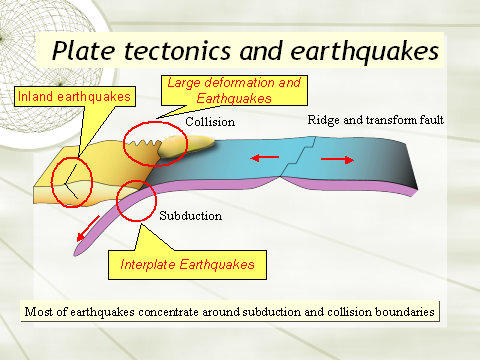




- Introduction
- Fundamentalists, Progressives & Moderates
- Did Jesus marry Mary Magdalene?
- The Jesus of Faith vs the Historical Jesus
- Do we have the actual words of Jesus?
- Has God inspired every dot and comma in the Bible?
- Can you be a Buddhist & a Christian?
- Was St Paul a misogynist?
- What is a fundamentalist?
- Eschatology & The End of Time
The Christian Faith
In this area of the website, I intend to contribute a number of essays on the Christian Faith in its earliest form. Though the Christian Faith was once the common religion in the West, one can no longer assume an understanding of it amongst the general population. For someone standing on the outside, it can be easy to misconstrue the nature of the Faith. Movements like Fundamentalism, particularly in North America, may sometimes seem to be mainstream when, worldwide, they are not. The universal failure of the Roman Catholic Church to deal with paedophilia has to be seen in the context of the major divisions of the Church. Attitudes toward the writings so central to the Faith (i.e., the Bible) are often forged with little understanding of the way in which the many documents were written, transmitted, collected and approved. The world-view of the authors needs explanation and translation. Whether you are a practitioner of the Faith, or someone on the outside who needs some knowledge of it in order to work efficiently in administration or diplomacy, I hope you will find these essays helpful. My background is that of a practitioner of the Faith. I am an ordained minister of a major Protestant Church in Australia, although now retired. However, my theological education came from doing a four year postgraduate degree in Divinity at the University of Sydney, Australia in the late 1970s and early 1980s. The University is a secular university and the degree was available regardless of religious faith. Whether you are a Christian wanting to reflect more deeply on some issues of faith, or a person looking in from the outside who just wants a better understanding of Christianity for whatever reason, I hope you will find my essays interesting. The topics will be listed as sub- menus under the “Christian Faith” button in the navigation bar above. Some topics have not yet been completed so those sub-menu items will not lead anywhere for the time being.








- Introduction
- Fundamentalists, Progressives & Moderates
- Did Jesus marry Mary Magdalene?
- The Jesus of Faith vs the Historical Jesus
- Do we have the actual words of Jesus?
- Has God inspired every dot and comma in the Bible?
- Can you be a Buddhist & a Christian?
- Was St Paul a misogynist?
- What is a fundamentalist?
- Eschatology & The End of Time
The Protestant Landscape of Belief
A Fundamentalist, a Progressive and a Moderate walk into a pub and the barman asks them “What’ll it be?” And the Fundamentalist says … Years ago I attended a convention in which the keynote speaker was Bishop Desmond Tutu from South Africa. He had many challenging things to say to a largely white audience and I noticed he began his speech every night with a joke. It helped to relax his audience and help them be more open to the things he had to say. I know from experience that the things I say can also cause upset, so I am trying to learn from a master of the trade. I regret that I need to work on the opening line above. In the past we have often understood Christians according to their ‘denomination’ - for example, Methodist, Baptist, Presbyterian, Lutheran, Anglican and so forth. However, I believe that such denominations have ceased to have the same relevance they once did because the things that unite or divide step across denominational boundaries. In my view there are three main divisions amongst Protestants today: Fundamentalists, Progressives and Moderates. If you are trying to understand Protestants today it may help to illustrate the different approaches. For this purpose I am going to use the creation stories in Genesis, and the resurrection accounts in the Christian Gospels, as illustrative of the differences. Consider the two Creation stories which open the first book of the Christian Bible, Genesis. In the first story, human beings are created on the last (6th) day of Creation and are given the right to reign as kings over the Creation. (Climate-change deniers should note that those who reigned as kings in the Bible were understood to be accountable to God for their actions, so this role of reigning over Creation was in effect one of accountable stewardship, not exploitation.) In the second Creation story, a man (as in male human being) is created and found to be lonely, so God creates a series of animals to see if any would be a suitable companion for the man, but they all fail. Finally God creates a woman and the man is delighted. These two Creation stories have conflicting sequences in the Creation. The Fundamentalists see the two stories as being literal accounts of the Creation, forcing them to go into a tortuous argument reconciling the different sequences. The Moderates and the Progressives on the other hand, see the Creation stories as myths in the technical sense of the word; that is, as stories which tell spiritual truths, not literal ones. So for them the point of the first Creation story is to acknowledge the role and responsibility of humans for the Creation. The point of the second story is that God has created men and women to be companions. Oft-quoted in this regard are the words usually attributed to this or that indigenous leader concerning the folklore of his people: “I don’t know whether this story actually happened, but I know that it is true”. So far we have the Moderates and Progressives on the same side; at least until we come to the resurrection stories in the Christian Gospels. Not surprisingly, for the Progressives, these are just metaphors. For the Progressives, the conflicting nature of the resurrection accounts at the literal level hints at their intended use as metaphors for life that rises above suffering. However, for Moderates, the conflicting nature of the resurrection accounts arises because the Gospel authors are selectively choosing episodes from the life of Jesus to express themes relevant to their audience. For example, Matthew’s Gospel, which appears to have been written for a Jewish-Christian congregation, presents Jesus as the ‘new Moses’ who delivers five bodies of teaching reminiscent of the five books of the Law of Moses from a mountain, echoing Mt Sinai. (The Sermon on the Mount is an outcome of this stance.) When Matthew comes to include resurrection accounts he is interested in only one (apart from the obligatory story of the women at the empty tomb). That account is of Jesus’ resurrection appearance on that mountain in Galilee, thus endorsing all that Jesus taught from the mountain. The Gospel authors were not interested in providing a precise chronological account of episodes in the life of Jesus. There would be little point to that and it would be somewhat tedious. In the same way that we might reflect on the particular moments that have been formative in our own lives, with little regard for the intervening moments, and even for the chronological order in which they occurred, so the Gospel authors have done with episodes in Jesus’ life. They are drawing out meaningful moments from the life of Jesus and presenting them in a way that addresses issues for their own generation and life-setting. This arrangement of episodes in the life of Jesus for the sake of presenting theological themes makes a chronological reconstruction virtually impossible. This obstacle to chronological reconstruction is an outcome of the genre of literature. The Moderates would say to the Progressives, “The apparent conflict in the resurrection accounts is not an indication that the accounts were intended to be myths inviting a metaphorical interpretation. It is the unavoidable outcome of the genre of literature which the Gospels illustrate. The confirmation of this understanding is found in the fact that the Gospels affirm the physicality of the resurrected Jesus.” The Gospels in the Christian Bible certainly do affirm the physicality of the resurrected Jesus, even if it at first appears that they do not. An example is found in the final chapter of the Gospel of Luke (Luke 24:13-48). After Jesus’ death two disciples are walking along the road to Emmaus when the resurrected Jesus joins them but is not recognised by them. Finally by evening, when they are having a meal, this unrecognised Jesus breaks the bread and the disciples recognise that it is Jesus. This story easily lends itself to metaphorical interpretation. It can be understood as a myth conveying a spiritual truth, not a literal one. Jesus may well have been killed by those who wished to destroy him, but he lives on in the hearts and minds of his followers and is especially ‘present’ with them when they break bread together. This is a great text for preaching and I have used it as such myself. However, the story of the disciples on the road to Emmaus does not end there. The two disciples on the Emmaus road join the rest of the disciples back in Jerusalem. While there, the risen Jesus appears to them and affirms his physical nature very strongly by asserting that he is not a ghost, but someone with flesh and bones who invites the disciples to both look at and touch him, and who asks for something to eat. A similar, physically present Jesus is affirmed in the Gospel of John. It appears that the Gospel of John went through a number of editions. An earlier edition appears to end with chapter 20, and a later edition with chapter 21. Both chapters affirm the physicality of the resurrected Jesus. Chapter 20 includes the famous story of Thomas who was not there at an earlier appearance of the risen Jesus. Jesus appears for Thomas and invites him to once again see and touch him. In chapter 21, the risen Jesus invites the disciples to have breakfast with him by the Sea of Galilee and distributes bread and fish among them. All of these stories lend themselves to metaphorical interpretation. In fact, modern day preachers depend on that in order to draw out relevance for a living faith today. Without that modern application, stories of the resurrected Jesus would just be pieces in a museum of ancient history. The crucial issue dividing Moderates from Progressives is whether the resurrection had some degree of physicality in the first place. Moderates say “yes” and Progressives say “no”. It is important here that the role of the historian not be confused with a stance of faith. In this instance, the role of the historian is not to determine what actually happened. That would be beyond the compass of history. The role of the historian is to determine whether the people who wrote the Gospels believed in a resurrection of Jesus that had some degree of physicality; a resurrection that was more than just a myth with metaphorical interpretation. The majority of Biblical scholars today would affirm that they certainly did. Whether we feel we can join the Gospel authors in that stance is a different issue altogether. So, a Fundamentalist, a Progressive and a Moderate walk into a pub and the barman asks them, “What’ll it be?” …. I’m still working on this one. If you have any ideas, send them in.






- Introduction
- Fundamentalists, Progressives & Moderates
- Did Jesus marry Mary Magdalene?
- The Jesus of Faith vs the Historical Jesus
- Do we have the actual words of Jesus?
- Has God inspired every dot and comma in the Bible?
- Can you be a Buddhist & a Christian?
- Was St Paul a misogynist?
- What is a fundamentalist?
- Eschatology & The End of Time
Click on photo to enlarge




Did Jesus marry Mary Magdalene?
When I was a child in school and was required to read a novel for analysis in English literature, I often found it easier, and faster, to see the movie version of the novel. Of course, this method had its traps, especially when the script writer for the movie decided to take liberties with the storyline of the novel. Nevertheless, many if not most people have an idea of the story of Jesus that is partly influenced by movies and other forms of literature, like Mel Gibson’s The Passion of Christ and Dan Brown’s novel The Da Vinci Code. One centuries-old storyline maintains that Mary of Magdala was the repentant prostitute described in the Gospel of Luke (7:37-50). This is the woman whom the Pharisees perceived as a great sinner in the town who came in and washed Jesus’ feet with her tears and wiped them dry with her hair because she had repented and been forgiven. Another storyline has Jesus marrying Mary Magdalene and having children by her, with descendants who are alive to this day. Some storylines even combine these two portraits of Mary. What are we to make of these claims? A vital factor in considering these arguments is the frequency of the names of ‘Jesus’ and ‘Mary’. Let’s visit that factor first.How common was the name Jesus?
In Western society the name ‘Jesus’ is very rare, except perhaps in Latin countries. In fact, in the Australian State of New South Wales, one is not permitted to use the name ‘Jesus’ at the registration of birth. This gives many the impression that the name ‘Jesus’ would have been very rare in ancient Israel as well. The opposite is true. Alexander the Great, and after his death his “Seleucid” generals, ruled over the former lands of Israel and imposed Greek culture, including Greek language, on their subjects. With the Maccabean revolt against the Seleucid monarch Antiochus IV Epiphanes, there was a resurgence of Jewish culture, which included a resurgence of the names of the patriarchs and matriarchs of ancient Israel. 1 One of those patriarchs was a man by the name of Joshua. Moses had led the people of Israel out of their slavery in Egypt through the desert and to the borders of the ‘Promised Land’. However, Moses died before the people entered the Promised Land and the task of leading the people into the Promised Land fell to a man named “Joshua”. (See Joshua 1:1-2). The name which is translated into English as “Joshua” actually underwent a shortening over time. Let’s take an example of the same thing happening in English. The name “Gregory” is usually shortened to the name “Greg”. We often joke in English about the fact that the only time we were called by our full name was by our mothers when we had done something wrong! Since there was no “J” sound in Hebrew, “Joshua” is a translation into English of the Hebrew name “Yehoshua” or “Yoshua”. After the Babylonian Exile, the name was frequently shortened and pronounced “Yeshua”, or just “Yeshu”. From this last shortening, the name was translated into Greek as “Yaysus” ( Ἰησοῦς ) and from the Greek into English as “Jesus”. It sounds a little complicated, but the point is that “Joshua” and “Jesus” are translations into English of the same name. The frequency of the name ‘Joshua’ in Western society gives us a better idea of the frequency of the name ‘Jesus’ in ancient Israel during this period. The ancient Jewish historian, Josephus, who lived in the generation just after Jesus, speaks of more than 20 men of historical significance whose name was ‘Jesus’, and ‘Jesus’ remained a popular name among Jews until the beginning of the 2nd century. 1 The Gospel accounts of the trial of Jesus involve the release of another prisoner instead of the release of Jesus of Nazareth. In Matthew’s Gospel we discover that the name of the other prisoner was Jesus Barabbas. Jesus? Which one were you looking for?How common was the name Mary?
So much for the name ‘Jesus’. What about the name ‘Mary’? The name ‘Mary’ was drawn from the name of Moses’ sister, ‘Miriam’. In the New Testament, ‘Mary’ is just a shortened form of the name ‘Miriam’. This becomes very obvious when you read the New Testament in the original Greek. The Gospels alternate between referring to the same person as “Maria” and “Mariam” (=Miriam). This is not evident in English because translators render both forms as “Mary”. However here is an example from Matthew’s Gospel. 56 Among them were Mary Magdalene, and Mary the mother of James and Joseph, and the mother of the sons of Zebedee. 57 When it was evening, there came a rich man from Arimathea, named Joseph, who was also a disciple of Jesus. 58 He went to Pilate and asked for the body of Jesus; then Pilate ordered it to be given to him. 59 So Joseph took the body and wrapped it in a clean linen cloth 60 and laid it in his own new tomb, which he had hewn in the rock. He then rolled a great stone to the door of the tomb and went away. 61 Mary Magdalene and the other Mary were there, sitting opposite the tomb. (Matthew 27:56-61 NRS) Now let’s go to the Greek text underlying the English translation. Don’t be daunted by this strange script. We are only looking at the name. All you need to look at are the two references to Mary Magadalene in this story about the burial of Jesus. The use of the colour purple for references to Mary Magdalene in the English text above, is duplicated in the Greek text below. The “r” sound in Greek is made using the letter rho ρ and the “m” sound by the letter mu μ. 56 ἐν αἷς ἦν Μαρία ἡ Μαγδαληνὴ καὶ Μαρία ἡ τοῦ Ἰακώβου καὶ Ἰωσὴφ μήτηρ καὶ ἡ μήτηρ τῶν υἱῶν Ζεβεδαίου. 57 Ὀψίας δὲ γενομένης ἦλθεν ἄνθρωπος πλούσιος ἀπὸ Ἁριμαθαίας, τοὔνομα Ἰωσήφ, ὃς καὶ αὐτὸς ἐμαθητεύθη τῷ Ἰησοῦ· 58 οὗτος προσελθὼν τῷ Πιλάτῳ ᾐτήσατο τὸ σῶμα τοῦ Ἰησοῦ. τότε ὁ Πιλᾶτος ἐκέλευσεν ἀποδοθῆναι. 59 καὶ λαβὼν τὸ σῶμα ὁ Ἰωσὴφ ἐνετύλιξεν αὐτὸ [ἐν] σινδόνι καθαρᾷ 60 καὶ ἔθηκεν αὐτὸ ἐν τῷ καινῷ αὐτοῦ μνημείῳ ὃ ἐλατόμησεν ἐν τῇ πέτρᾳ καὶ προσκυλίσας λίθον μέγαν τῇ θύρᾳ τοῦ μνημείου ἀπῆλθεν. 61 ἦν δὲ ἐκεῖ Μαριὰμ ἡ Μαγδαληνὴ καὶ ἡ ἄλλη Μαρία καθήμεναι ἀπέναντι τοῦ τάφου. (Matthew 27:56-61 GNT) As you can see, the reference to “Maria” Magdalene at the beginning turns into “Mariam” (=Miriam) Magdalene at the end. Mary Magdalene was thus also named after the matriarch “Miriam”, a prophetess and sister of Moses. Even in this brief passage we can see that other Marys were also known. So just how many women were named Mary after Miriam? The short answer is “a lot”. The discussion above about names may seem rather academic, but its usefulness will soon be apparent.Was Mary Magdalene the Repentant Prostitute of Luke’s Gospel?
The identification of Mary Magdalene as the “sinful woman” of Luke 7:37-50 never occurs in the four canonical Gospels. This identification came later as some contemplated the characters and events in the Gospel story. Most scholars agree that the unnamed woman described in Luke 7:37-50 was a repentant prostitute who annointed Jesus’ feet with her tears. But there is also another woman who anoints Jesus’ feet, this time with expensive ointment. She is the ‘Mary of Bethany’ of John’s Gospel chapter 12. As early as Augustine, church leaders were beginning to identify the nameless woman in Luke’s Gospel with the ‘Mary of Bethany’ in John’s Gospel, on the basis of the common action of anointing Jesus’ feet. The second step was the identification of Mary Magdalene with Mary of Bethany. This identification was first made by Ephraim the Syrian (306-373 C.E.) but gained official standing by the time of Pope Gregory the Great (540-604 C.E.) However, we know that so many women were named Mary that a simple identification on the basis of that name alone is impossible. Other things, such as place of origin, were used to distinguish between Marys. Mary Magdalene, otherwise known as Mary of Magdala, came from the town of Magdala on the western shores of the Sea of Galilee. Mary of Bethany came from a small village on the eastern outskirts of Jerusalem. Take a look at the adjacent satellite map and locate Magdala and Bethany. There is no way, on the basis of that identification, that we are dealing with the same woman. Magdala and Bethany are not adjoining suburbs. In direct line they are 120 km (approx 75 miles) apart, and much further by road. In addition, some looked at the storyline in Luke’s Gospel, in the chapter after the incident with the repentant prostitute, and found that Mary Magdalene was introduced there as a woman from whom seven devils had been cast out. They assumed this referred to sexual immorality. However, such a diagnosis never refers to sexual sin. Rather it is a reference to a very sick woman being healed. We must conclude that, in the Gospels, Mary of Magdala was never identified with the repentant prostitute of Luke 7, nor with Mary of Bethany, and that attempts to do so by later commentators run afoul of the facts. 2 So, did Jesus marry Mary Magdalene?The Literature
It may seem we have taken a long time to get to this question, but the information above helps us to evaluate this claim. None of the four canonical Gospels, (Matthew, Mark, Luke and John), ever states or even hints at the idea that Jesus married Mary of Magdala. However, the idea that Jesus was married does emerge in some non-canonical works which have been loosely dubbed ‘Gospels’. This includes a mere fragment the size of a credit card which contains text as follows: “And Jesus said, My wife …” before the fragment ends. This tiny fragment is all there is of a document which has been dubbed ‘The Gospel of Jesus’ Wife’. Professor Karen King, the Harvard scholar who brought this fragment to public notice, has been quite clear in saying that the document is too late to give any historical information about Jesus of Nazareth, but it seems that the temptation to announce a sensational claim about Jesus has been too great for some journalists. Further, while the document has Jesus referring to “my wife”, it does not identify Mary Magadalene as this wife. Another document known as the “Gospel of Philip” is dated from the end of the 2nd century or the beginning of the 3rd century. This ‘Gospel’ is strongly Gnostic in its outlook. It refers to Mary of Magdala as a “koinonas”, which has a range of meanings, one of which could mean ‘sexual companion’. In such situations of ambiguity the meaning is taken from the context, but there is nothing in the context which would lead to the inference that Mary Magdalene was Jesus’ sexual partner. In any case, once again we have a document which is too late to provide accurate historical information about Mary Magdalene.The Ossuaries
So
much
for
the
‘Gospels’
which
were
never
included
in
the
Bible,
but
there
is
another
source
for
speculation
that
Mary
Madgalene
was
married
to
Jesus.
Ossuaries
are
‘bone
boxes’
and
it
would
appear
that
ancient
funeral
customs
among
the
Jews
involved
waiting
until
the
flesh
had
been
dissolved before collecting the bones and placing them in these ossuaries.
The
significance
of
these
ossuaries
lies
in
the
possibility
that
one
might
be
found
containing
names
which
correspond
with
the
names
of
Jesus’
family,
including
a
Mary
that
is
presumed
to
be
Mary
Magdalene.
For
example,
what
is
the
significance
of
finding
ossuaries
with
the
names
of
“Jesus,
son
of
Joseph
and
brother
of
James
(Jacob).
By
now
the
reader
should
be
able
to
see
the
problem
of
identifying
such
funeral
items
as
those
of
Jesus
of
Nazareth
and
his
family.
So
many
people
were
named
after
the
patriarchs
and
matriarchs
of
ancient
Israel
during
this
time
period
that
quite
a
number
of
tombs
might
hold
these
combinations
of
names.
Everyone
in
Jesus’
family,
including
Jesus,
was
named
after
one
of
the
patriarchs
or
matriarchs
of
ancient
Israel.
Indeed,
this
was
the
custom
at
the
time.
It
is
not
so
much
a
matter
of
finding
a
collection
of
ossuaries
with
the
names
of
Jesus
and
his
family,
but
of
which,
if
any,
collection
of
such
ossuaries,
with
such
names,
do
you
propose
is
the
family
tomb of Jesus?
The canonical Gospels maintain that Jesus rose from the dead and that his body was absent from the tomb, not laying in it. The claim that the remains of Jesus have been found in a tomb runs counter to this. “Progressive” Christians claim to be unaffected by the possibility that Jesus’ remains could be found, since they interpret the resurrection metaphorically; but “Moderates” and “Fundamentalists” would be affected by this. However, on the basis of the evidence we have examined, they have little to fear. Then who was Mary Magdalene? The short answer is a rather extraordinary woman!A woman healed by Jesus
We learn from Luke’s Gospel (chapter 8) that she had been a woman from whom “seven demons had gone out”. Of course, this reflects a first century worldview and it is difficult for us to find an answer to our 21st century questions. The Gospel writers cannnot provide answers to questions they never asked. But it is interesting that the situation is lumped together with those who had been healed of their infirmities. We might reasonably assume that Mary of Magdala had been a very sick woman and that in the course of his ministry, Jesus had liberated her from this condition. A wealthy woman The second factor is that Mary of Magdala tops the list of those women who provided for Jesus and the disciples out of their resources (Luke 8:1-3). Many have never wondered how Jesus and his close band of disciples were able to wander about the regions of Galilee, Samaria and Judea - indeed even beyond that - when they had given up their employment and with it their income. It would appear that Mary Magdalene had some wealth behind her, possibly from the fishing industry and the textile industry in Magdala, and, to put it crudely, she helped bankroll Jesus’ mission. A very courageous woman who became “the apostle to the apostles” It is obvious from the canonical Gospels that Jesus had women disciples. Some are listed by name, and Mary Magdalene is always at the top of the list. Her devotion to Jesus’ mission is shown in the fact that she is the only disciple, according to the first three Gospels, who has the courage to remain with Jesus’ mother and aunty at the scene of the crucifixion as they wait for Jesus to die. She accompanies Jesus’ body to burial, and she is named first with those women who find the tomb empty. Specifically, in John’s Gospel, she is the first person to whom the risen Jesus appears (John 20). Her commission is to go to the other disciples and tell them she has seen the risen Jesus. For this reason, amongst the Eastern Orthodox Churches, she is known as “the apostle to the apostles”. The word “apostle” comes from the Greek verb “to send”, and so Jesus sends out the apostles by sending Mary Magdalene as an apostle to them. Jesus’ Leading Female Disciple We know from Paul’s letters that women, especially those wealthy enough to have larger houses, were leaders in the earliest Christian house churches. It would be consonant with that fact to assume that Mary Magdalene was a leader amongst the disciples. She is always named first in a list of female disciples, just as Peter is named first in the list of male disciples. In the Greek in which the Gospels were originally written, her name occurs with the definite article before Magdalene, implying that she was a person of particular importance. In later writings which were not included in the Bible, Mary Magdalene is portrayed as being in theological debate with St Peter, against whom she normally wins. Such a view would certainly be in harmony with the canonical Gospels. There is, however, no evidence that Mary Magdalene was the spouse of Jesus. For a more detailed analysis, I recommend the book by Dr Mary R. Thompson, Mary of Magdala (Revised Edition) What the Da Vinci Code Misses. 2006. Sisters of St Mary of Namur, Inc. Footnotes: 1) For more details on this, see J.P. Meier. A Marginal Jew . Volume 1.Doubleday.1991pp205-208. 2) It interesting to find that in the Tridentine Mass in the Roman Catholic Church the feast of St Mary Magdalene had the set Gospel reading as Luke 7 - “the sinful woman”. However, the modern Mass has changed this to John 20, Mary Magdalene as the first witness to the resurrected Jesus.


Click on map to enlarge




- Introduction
- Fundamentalists, Progressives & Moderates
- Did Jesus marry Mary Magdalene?
- The Jesus of Faith vs the Historical Jesus
- Do we have the actual words of Jesus?
- Has God inspired every dot and comma in the Bible?
- Can you be a Buddhist & a Christian?
- Was St Paul a misogynist?
- What is a fundamentalist?
- Eschatology & The End of Time
The Jesus of Faith versus the Jesus of History
It was in one of those moments when I sat down to have some lunch and turned on the television as a distraction. Chance would have it that the current channel was airing an interview with a young man who had recently gained his doctorate in the study of Jesus of Nazareth. From the beginning of the interview, he wished to strongly assert that he was concerned not with the Jesus of Christian Faith, but with the real, historical Jesus.The Jesus of Faith
The observation is a well-known one amongst Biblical scholars. It does not take long to realise that the
four Gospels in the Christian New Testament approach the story of Jesus from the point of view of faith in
him. Some of the Gospels make this quite explicit, like the Gospel of John which comes to its first ending
with the words:
“ Now Jesus did many other signs in the presence of his disciples, which are not written in this book. But these are written so that you may come to believe that Jesus is the Messiah, the Son of God, and that through believing you may have life in his name.” (John 20:30-31 NRS.) Furthermore, a deeper study of the construction of the four Gospels reveals how each author rearranges the sequence of stories to suit a theological purpose. For example, in the first three Gospels, the story of Jesus is arranged around three main segments: the powerful ministry in Galilee; the journey to Jerusalem construed as a call to the pathway of discipleship; and the death and resurrection of Jesus in Jerusalem. The so-called “cleansing of the Temple”, when Jesus throws the merchants out of the Temple in Jerusalem, occurs at the end of the story as a part of the provocative actions that lead to Jesus’ death. However, the author of John’s Gospel moves this “cleansing of the Temple” to the beginning of the story, where it stands as a programmatic symbol over the whole of Jesus’ ministry. Consequently, the readers of John’s Gospel know that everything that Jesus said or did right from the start, was a challenge to, and rejection of, the worship centred on the Jerusalem Temple at this time. In this, Jesus and his followers shared a perspective with the Essenes at Qumran, who had retired to their Dead Sea community in disgust. This insight, into the theological underpinnings of the way the story of Jesus was told in the Gospels, led to a desire to search for a more objective view of Jesus; one which was more amenable to the historian. There thus began the quest for the “historical Jesus”. The intention of the quest seemed reasonable enough. After all, not everyone saw the real Jesus through the eyes of faith. His enemies most certainly did not. “Jesus was a magician who led Israel astray!” maintained one contemporary line of thought. Unfortunately, the quest for the historical Jesus ran into some major problems, and it is much easier to show this by following the quest along its path just a little way.Jesus, the “Man of the Lie”
It was a privilege, while studying for a post-graduate degree in Divinity at the University of Sydney, to have Barbara Thiering as a lecturer. Thiering had a theory about the historical Jesus which, while not part of the syllabus, always seemed to be slipped through into discussions. Thiering’s theory maintained that John the Baptist was the “Teacher of Righteousness” mentioned in the Dead Sea Scrolls, and that Jesus was the person referred to in the same scrolls as the “Man of the Lie”. Her theory maintained that talk of miracles consisted of “deliberately constructed myths”, which the initiated could understand as revealing esoteric historical events. Thiering’s thesis thus maintained that the real, historical Jesus did not perform miracles. Indeed, Jesus had been married, divorced and married again, according to Thiering’s “peshur” technique of interpreting the Gospels. Thiering’s theory has been universally rejected by scholars, including Jewish scholars who have no stake in supporting the Jesus of Christian Faith. Criticisms have focused on Thiering’s own “peshur” technique to supposedly unravel the truth of the Gospels, and her anachronistic link between particular Dead Sea Scrolls documents that were written prior to Jesus of Nazareth’s lifetime and could not possibly be referring to Jesus of Nazareth. However, the virtually unanimous rejection of Thiering’s historical Jesus has not been paralleled by some of the other so-called historical Jesus figures. In 1975, Malachi Martin, a Jesuit priest and former professor at the Pontifical Biblical Institute, published a book called Jesus Now , 1 in which he outlined examples of the numerous figures of Jesus that had been created over time. In a more recent book, Fabricating Jesus , 2 Craig Evans takes the reader on a journey through many of the fabrications, with a scholarly examination of each one of them.Jesus the Cynic Philosopher
In these books one will find “Jesus the Cynic philosopher”, who clings to and reflects Hellenistic culture. This proposal comes from John Dominic Crossan. Here it is argued that the proximity of the city of Sepphoris to Jesus’ hometown of Nazareth would have exposed Jesus to Greek culture and philosophical thought. Comparisons are drawn between the teachings of Jesus and the ideals of the Cynics. While there are some superficial similarities, there is no likelihood that Jesus and his followers would have embraced some teachings of the Cynics, such as urinating, defecating and having sexual intercourse in public. Furthermore, archaeological evidence shows that prior to the Jewish revolt of 66-70 A.D. and thus during the lifetime of Jesus, Sepphoris was a mainly Jewish city, not the haunt of Cynic philosophers.Jesus the Rabbinical Jew
From the opposite side comes “Jesus the Rabbinical Jew”, who supposedly never intended to have people reject the Law of Moses. While the other Gospels have Jesus say that he came to fulfil the Law of Moses, they do not go on to explain what that means. However, Matthew’s Gospel expands this statement into an assertion by Jesus that he did not come to destroy the Law and that the Law of Moses remains until the end of the age (Matthew 5:17-18). Unfortunately, there is a final clause in the statement attributed to Jesus in Matthew’s Gospel that the Law only remains “till all is accomplished”. As John P. Meier points out in his brilliant commentary on Matthew’s Gospel 3 , Matthew not only expands the saying of Jesus about fulfilling the Law of Moses, he also expands the account of the death and resurrection of Jesus to include a much wider resurrection of the dead – a sign of the end of the age! (Matthew 27:50-53) Promoters of “Jesus the Rabbinical Jew” have been known to precede their presentation with a screening of a documentary on Christian anti-Semitism, presumably in their belief that guilt over this will prevent their audience from perceiving Jesus’ teaching as being on a collision course with Rabbinic Judaism. In practice, it is perceived as an attempt at emotional manipulation. Promoters of the figure of Jesus the Rabbinical Jew have to deal with inconvenient passages like Mark 7, where Jesus dismisses Jewish food laws on the basis of the principle that it is not what goes through the digestive system that makes a person unclean, but the things that come out from the heart. Mark adds to this the comment, “Thus he declared all foods clean”. Jewish scholars like Amy-Jill Levine suggest that Mark’s comment misunderstands Jesus. This reflects a degree of naiveté, for Mark is as much in control of the teaching he attributes to Jesus, as his comments upon it. Behind much of this rejection of the “Jesus-of-Faith” in the figure of “Jesus-the-Rabbinical-Jew” is a refusal to believe that Jesus (a Jew) and his Twelve Apostles (all Jews) could have been involved in a revolutionary re-interpretation of Judaism.The Fantastik Jesus
Malachi Martin delivers a number of ‘takes’ on Jesus which he groups under the heading of “The Fantastik Jesus”. One example concerning the resurrection story might give us some comic relief: “Heinrich Paulus, in the last century, did not quite agree with anybody. He had fresh ideas. First of all, Jesus’ feet were not nailed. At nightfall he detached his hands from the nails and simply ran off into the woods and hills. Paulus does not agree with others that the Resurrection was an hallucination (collective or individual) which the followers of Jesus had. Much more prosaic! When Jesus ran off Joseph of Arimathea dressed his wounds and clothed Jesus in the gardener’s clothes. Mary Magdalene, half-crazed with sorrow, saw him, thought he was the gardener; but this miffed Jesus and he called out her name. When she wanted to embrace him, he said: ‘Don’t touch me.’ For a very good reason. He was aching all over from the scourging he had received. Then, Paulus concludes, Jesus took off for Galilee, where he died shortly after of tetanus infection.”The (19th Century) Scientist’s Jesus
With the rise of reason and science in the 18 th and 19 th centuries, confidence grew in the use of the tools provided. This included not only the ‘hard’ sciences, like physics and chemistry, but also the social sciences, such as sociology, anthropology, history, languages and archaeology. Anything that was not accessible to such investigations was not seen to be credible. Miracles and resurrections had to go. Jesus was simply a man with some good ideas about moral behaviour. There were no supernatural events; these were myths and stories imposed upon Jesus by the culture and expectations of his people and his time. Strip them away and what you have is the “historical Jesus”. This was the origin of 19 th Century Liberalism in theology. One might note in passing that 19th Century Liberalism was firmly attached to notions of 19 th century science.Problems with the Historical Jesus
These are just a few attempts at the ‘real, historical Jesus’, and as somebody once sarcastically said, “The beautiful thing about the ‘real, historical Jesus’ is that there are just so many conflicting ones to choose from! It is the sheer multiplicity of these claims which raises questions about the validity of each one of them. They can’t all be right, and perhaps none of them are. The problem for the notion of the ‘real, historical Jesus’ is first of all that of the objectivity of the researchers. As one researcher pointed out, the search for the historical Jesus is like looking down into a very deep well and seeing a dim reflection of yourself at the bottom. Such is the ambiguity of the evidence outside of the material presenting the Jesus of Christian Faith, that one’s construction of the ‘real, historical Jesus’ is likely to tell others more about oneself, than about Jesus. The second realisation is that there is no objectivity in this game. The Jesus of Christian Faith is no less objective than all the other ‘creations’; and it just happens to be the one with the most documentary support! Indeed, so many examples claiming to present the real, historical Jesus, declare passages to be spurious simply according to whether they suit the theory. As Evans demonstrates 2 , there are also numerous examples of claimants assuming what they need to prove. For example, members of the Jesus Seminar assume that Jesus was illiterate. From this they proceed to draw certain conclusions, “Given that Jesus was iliterate …”. This shows the problem of assuming that which one needs to prove. Careful research shows that Jesus is not likely to have been illiterate. A further thing needs to be said, especially since we live in an age where science has gained so much trust. The scientist’s Jesus above is the creation of 19 th century science and that is very much different from science today. In the 19 th century, there was a deluded belief that science had pretty much revealed all that was to be found. In their account of the beginnings of Quantum Physics 4 , Bruce Rosenblum and Fred Kuttner describe how Max Planck announced his interest in physics to the chairman of the physics department. He was told that he should choose something more exciting, because “All the important discoveries have already been made.” Planck continued undeterred and in the last week of the 19 th century he announced that the most fundamental laws of physics were being violated. It was the dawn of the age of quantum physics. Around the same time, Albert Einstein was being raised to prominence with his theories of General and Special Relativity. These new discoveries would move science from its self- satisfied acquiescence to a new era of ongoing discovery and mystery. In fact, science itself was falling victim to the social sciences through the study of the epistemology of knowledge and the realisation that “what everybody knew to be true” was not necessarily a good indication of what was actually true. When Copernicus maintained that the Earth revolved around the Sun, everybody ‘knew it could not be true’. People would surely fall off the Earth! But it was true, and what ‘everybody knew to be true’ had to be changed. The confident assertions that certain things could not have happened in the life of Jesus, were no longer such confident assertions at all. And that suggests that the Jesus of Christian Faith might even deserve a second chance. Footnotes: 1) Malachi Martin. Jesus Now . 1975.William Collins & Sons. Glasgow. 2) Craig Evans. Fabricating Jesus . How Modern Scholars Distort the Gospels . 2006. InterVarsity Press. 3) John P. Meier. Matthew . 1980. Veritas Publications. Dublin. 4) Bruce Rosenblum and Fred Kuttner. Quantum Enigma . Physics Encounters Consciousness.2006. Oxford University Press.



Miracles








- Introduction
- Fundamentalists, Progressives & Moderates
- Did Jesus marry Mary Magdalene?
- The Jesus of Faith vs the Historical Jesus
- Do we have the actual words of Jesus?
- Has God inspired every dot and comma in the Bible?
- Can you be a Buddhist & a Christian?
- Was St Paul a misogynist?
- What is a fundamentalist?
- Eschatology & The End of Time
Do we have the actual words of Jesus?
We could answer this question in a very brief sentence, but if we approach it more deeply we will also appreciate some of the silly assumptions we often make, whether consciously or unconsciously. One woman approached her pastor to complain about the use of modern English translations of the Bible in her church. “We no longer hear the actual words of Jesus when the Bible is read out!” she said. Behind her complaint was the fact that most churches no longer use the King James translation of the Bible; and her assumption that the King James translation contained the actual words of Jesus. A moment’s thought and we realise how silly this is, but until the question is drawn to our attention we may unconsciously assume that because the King James translation is ancient, and Jesus is ancient, that particular translation of the Bible contains the actual words of Jesus. To put things in proper perspective, let’s locate the place of “King James English” on a timeline of translations for those people inhabiting the land we call “England”. We’ll go from the modern translations backward to some of the earlier ones.Mark 1:1-3, New Revised
Standard Version
1989
Contemporary English
The beginning of the
good news of Jesus
Christ, the Son of God.
2 As it is written in the prophet Isaiah, "See, I am sending my messenger ahead of you, who will prepare your way; 3 the voice of one crying out in the wilderness: 'Prepare the way of the Lord, make his paths straight,'"Mark 1:1-3 King
James Version
1611/1769
Early Modern English
The beginning of the
gospel of Jesus Christ,
the Son of God;
2 As it is written in the prophets, Behold, I send my messenger before thy face, which shall prepare thy way before thee. 3 The voice of one crying in the wilderness, Prepare ye the way of the Lord, make his paths straight.
Mark 1:1-3,
Tyndales New Testament
1534
The beginnynge of the
Gospell of Iesu Christ the
sonne of God
2 as that is wrytten in the
Prophetes: beholde I
sende my messenger
before thy face which shall
prepared thy waye before
the.
3 The voyce of a cryer in
the wildernes: prepare ye
the waye of the Lorde
make his paches streyght.
Mark 1:1-3, AngloSaxon
Prior to Norman
Invasion
<1066
Her ys godspelles angyn
Hælendes Cristes,
Godes suna.
2 Swa awriten is on ðæs
witegan bec Isaiam, Nu!
ic asende minne engel
beforan ðinre ansyne,
se gegearwaþ ðinne
weg beforan ðe.
3 Clypigende stefen on
ðam westene,
Gegearwiaþ Drihtnes
weg, doþ rihte his siðas.
As
we
can
see
from
the
table
above,
the
Bible
was
translated
into
the
language
of
people
living
in
what
is
now
called
England,
across
the
centuries.
These
samples
of
such
translations
show
that
‘King
James
English’,
or
‘Early
Modern
English’
as
it
is
technically
known,
was
not
spoken
in
England
(or
anywhere)
for
more
than
a
1,000
years
after
the
time
of
Jesus
of
Nazareth.
While
King
James
English
may
seem
ancient
to
some,
it
is
a
relatively modern language.
We
can
appreciate
the
way
in
which
the
King
James
Bible
was
responsible
for
helping
to
standardise
English
across
the
many
village
dialects
at
the
time.
We
can
praise
the
translators
for
the
beautiful
flow
of
their
English
translation.
But
as
for
giving
us
the
actual
words
of
Jesus,
it
does
not.
Indeed,
why
would
Jesus
speak
such a language when nobody in those days in his part of the world would have understood him?
When
people
are
first
introduced
to
the
Christian
Bible
in
an
English
translation
there
is
often
an
unconscious
assumption
that
Jesus
spoke
English
-
even
King
James
English,
if
that
is
the
translation
they
have
first
heard.
Such
people
are
not
the
only
ones
to
make
such
an
unconscious
assumption.
Consider
a
science-fiction
TV
series
like
Star
Trek.
Have
you
ever
wondered
why
aliens
in
the
far
reaches
of
the
galaxy
always
seem
to
speak
English
in
such
shows?
Of
course,
there
are
some
exceptions.
But
then,
the
Gospels
have even been translated into Klingon!
The Languages of Jesus: Hebrew, Aramaic and Greek
Jesus
spoke
the
languages
of
his
people;
that
is,
Hebrew
Aramaic
and
Greek.
Hebrew
was
the
language
of
the
people
of
Israel
from
ancient
times.
However,
after
the
return
from
the
Exile
in
Babylon,
many
Jews
spoke
Aramaic.
Aramaic
was
akin
to
Hebrew
and
from
the
time
of
Jesus
to
this
day,
Hebrew
was
and
is
written
in
the
square
Aramaic
(Assyrian)
script.
Prior
to
that,
the
Hebrew
language
was
written
in
the
older
Hebrew
script, now dubbed ‘paleo-Hebrew’.
The
imposition
of
Greek
culture
and
language,
in
the
empire
of
Alexander
the
Great,
and
later
under
his
generals,
carried
into
the
Roman
Empire
during
the
time
of
Jesus
and
became
the
common
language
of
the
Empire.
In
his
earlier
years
as
a
carpenter,
Jesus
probaby
spoke
Greek
in
the
course
of
doing
business
in
a
multicutural
society.
Whether
this
meant
that
he
could
“get
by
with
Greek”
or
that
he
spoke
it
fluently,
remains
a
matter of debate. The majority view is that Jesus taught in Aramaic.
Since
the
Gospels
of
the
New
Testament
were
originally
written
in
Greek
and
relay
Jesus’
teaching
in
that
language,
the
assumption
that
Jesus
spoke
Aramaic
means
that
we
do
not
have
the
actual
words
of
Jesus.
Those
who
read
the
Gospels
in
English
have
a
further
translation
of
Jesus’
words:
from
Aramaic
to
Greek,
and
then
from
Greek
into
English.
In
response
to
this
situation,
some
ask
for
a
word-for-word
translation,
but
translation
is
not
that
simple.
Numerous
times
in
the
Gospels
it
is
stated
that
Jesus
had
compassion
on
the
crowds.
In
the
original
Greek
of
the
Gospels
it
is
actually
stated
that
Jesus
was
“moved
in
his
bowels”
concerning
the
crowds.
This
is
because,
in
the
Greek
culture
and
language
of
the
time,
the
bowels
were
considered
the
seat
of
the
emotions.
To
an
English-speaking
Westerner
today,
being
moved
in
one’s
bowels
is
usually
a
sign
of
a
gastric
infection.
To
understand
the
ancient
expression
we
have
to
use
a
different
metaphor
by
moving
things
up
a
tier
and
saying
that
Jesus
was
“moved
in
his
heart”
with
compassion. Thus a word-for-word translation would lead us astray.
It
is
often
said
in
the
context
of
Biblical
translation
that
“translation
is
translation
of
meanings,
not
words”.
The
challenge
for
the
translator
is
to
walk
the
fine
line
between
a
paraphrase
that
captures
the
meaning
on
the
one
hand,
and
an
interpretation
of
the
text
on
the
other.
The
translation
should
leave
open
the
same
possibilities
for
different
interpretation
as
the
original.
A
translator
too
immersed
in
his
or
her
own
modern
culture
may
assume
they
understand a text all too soon.
The
understanding
that
“translation
is
translation
of
meanings,
not
of
words”
should
not
disturb
us.
It
is
highly
likely
that
Jesus
used
the
same
element
of
teaching
in
several
places,
and
the
exact
wording
probably
differed
on
each
occasion.
What
we
have
are
traditions
of
those
sayings
which
were
validated
by
the
communities
which
still
had
those
among
them
who
had
known
Jesus
and
were
familiar
with
the
points he made.
Has the text become corrupted?
The
copying
of
the
original
manuscripts
of
the
Gospels
was
done
by
hand,
one
copy
at
a
time.
The
printing
press
had
not
been
invented.
As
scribes
moved
back
and
forth
from
the
manuscript
from
which
the
copy
was
being
made,
to
the
copy
itself,
errors
naturally
crept
in.
The
vast
majority
of
these
errors
are
insignificant,
and
the
supply
of
manuscripts
so
abundant,
that
textual
scholars
have
a
good
chance
to
work
their
way
back
to
the
original
text.
It
is
not
simply
a
matter
of
seeing
how
many
manuscripts
say
this,
and
how
many
say
that.
If
an
error
creeps
in
and
a
hundred
copies
are
made
of
the
manuscript
with
the
error,
simply
counting
up
manuscripts
would
arrive
at
the
wrong
conclusion.
Rather
textual
scholars
discern
“families”
of
texts
where
it
can
be
seen
at
what
point
an
error
has
crept
in,
and
other
families
of
texts
which
are
free
from
that
particular
error.
The
result,
every
so
many
years,
is
a
Greek
text
of
the
New
Testament
established
by
careful
evaluation
of
the
most
ancient
manuscripts.
For
some
time,
textual
scholars
have
been
using
the
27th
edition
of
the
Nestle-Aland
Text
as
the
established
text
of
the
New
Testament.
I
believe
the
28th
edition
has
now
been
released.
This
process
is
ongoing
and
only
recently
a
manuscript
of
Mark’s
Gospel
was
discovered
which
scholars
have
dated
to
the
first
century.
To
gain
an
insight
into
this
work,
visit
the
website of
The Centre for the Study of New Testament Manuscripts.
The
King
James
version
of
the
Bible
was
translated
from
manuscripts
in
the
original
Hebrew,
Aramaic
and
Greek.
However,
compared
to
the
manuscripts
we
have
available
today,
those
manuscripts
were
fairly
late,
and
include
errors
that
crept
in
over
time.
For
this
reason,
modern
translations
of
the
Bible
into
English
go
back
to
the
earliest
manuscripts.
Consequently,
modern
English
translations
of
the
Bible
not
only
render
the
Bible
in
language
more
easily
understood today, they also deliver a translation which is closer to the original text.
Two Definite Corruptions
The Ending of Mark’s Gospel
However, there are two places where the majority of scholars believe the text is not that of the author of the Gospel. The first place is the end of Mark’s Gospel. The oldest manuscripts of Mark’s Gospel end at chapter 16 verse 8, with the women fleeing the empty tomb. This seems to be an odd place to end the story, especially because it says the women fled the tomb and told no one because they were afraid. How did the author know this if they told no one? There has been a lot of speculation about the ending of Mark’s Gospel. Some think the original ending was lost and that the later endings were created to try and fill the void. However, I have often wondered whether the suspenseful end of the Gospel is there by design. Mark’s Gospel is the earliest of the four Gospels in the Bible. Its frequent use of the ‘historic present’ 3 suggests it was meant to be read aloud as a story in a single sitting. The ending of Mark’s Gospel, with the women fleeing the tomb, leads immediately to the question, “What happened then?” There would have been enough of those witnesses to the resurrected Jesus still alive at this time for the audience to be invited to personally interview the witnesses. We see a similar approach to education when school children learning about a war conclude their studies with a visit to veterans in a nursing home. Of course, my suggestion is dependent on the resurrection being an objective event. Progressives might also suggest that the ending is as designed, with the fleeing women finding Jesus in Galilee in a metaphorical kind of way. It appears that some thought to make up for a deficiency by writing an ending for the Gospel. There are at least two alternative endings to Mark’s Gospel which appeared over time - the shorter and the longer ending. Those who added these endings appear to have gathered information from the other Gospels and the Acts of the Apostles to fill in the void. Since the longer ending seems to have been interpreted by a sect in the USA as a commission to handle poisonous snakes, the revelation that this ending is not authentic comes as a relief. There are in fact five different endings. The more academically inclined are referred to the reference below. 1 For an introduction to the debate about these endings see the second reference below. 2The Story of the Woman Caught in Adultery
The revelation of the other inauthentic text has not been met with such joy. It concerns the story of the woman caught in adultery, usually found in John’s Gospel (8:2-11), but sometimes in manuscripts of Luke’s Gospel. The story is famous for Jesus’ line: “Let the one without sin cast the first stone.” The story does not appear in manuscripts of John’s Gospel until the fourth century. We only know it appeared then because of a comment made by two early Church leaders expressing surprise. In fact, the earliest manuscript we have of John’s Gospel containing the story is dated to the 5th century. Clearly, on the evidence at hand, this story was not part of the authentic Gospel of John. There is some evidence that a story a bit like it circulated separately from the Gospels, but if the story was authentic we would have expected those who inserted it to have been open about it and ready to share the evidence. On the evidence before us, we would have to say that this famous sentence attributed to Jesus is not an authentic part of the Gospel of John. Conclusion So, do we have the actual words of Jesus? The short answer is no, if we take that question quite literally. We do not have the Aramaic words which Jesus probably used. What we have are Gospels emerging from the earliest Christian congregations amongst whose membership were some who had met and listened to Jesus. Like most people at this time, they were multilingual, and they chose to present the words of, and about, Jesus in Greek in order to ensure the widest readership possible. Footnotes: 1) Philip W. Comfort. New Testament Text and Translation Commentary . 2008. Tyndale House. 2) David Alan Black (ed) Perspectives on the Ending of Mark . 4 Views. 2008. Broadman & Holman. 3) The ‘historic present’ involves the use of the present tense to describe past events. For example, “He sees him and he walks over and says to them …”. In a written account this would read instead as, “He saw him and he walked over and said to them …”. The ‘historic present’ is the mark of the storyteller who uses this technique to make his audience feel as if they were right there in the midst of the action.
The Shorter Ending
And
all
that
had
been
commanded
them
they
told
briefly
to
those
with
Peter.
And
afterward
Jesus
himself
sent
out
through
them,
from
the
east
and
as
far
as
the
west,
the
holy
and
imperishable
proclamation
of
eternal
salvation. Amen.
The Longer Ending
Now
after
he
rose
early
on
the
first
day
of
the
week,
he
appeared
first
to
Mary
Magdalene,
from
whom
he
had
cast
out
seven
demons.
She
went
out
and
told
those
who
had
been
with
him,
while
they
were
mourning
and
weeping.
But
when
they
heard
that
he
was
alive
and
had been seen by her, they would not believe it.
After
this
he
appeared
in
another
form
to
two
of
them,
as
they
were
walking
into
the
country.
And
they
went
back
and
told
the
rest,
but
they
did
not
believe
them.
Later
he
appeared
to
the
eleven
themselves
as
they
were
sitting
at
the
table;
and
he
upbraided
them
for
their
lack
of
faith
and
stubborness,
because
they
had
not believed those who saw him after he had risen.
And
he
said
to
them,
‘Go
into
all
the
world
and
proclaim
the
good
news
to
the
whole
creation.
The
one
who
believes
and
is
baptised
will
be
saved;
but
the
one
who
does not believe will be codemned.
And
these
signs
will
accompany
those
who
believe:
by
using
my
name
they
will
cast
out
demons;
they
will
speak
in
new
tongues;
they
will
pick
up
snakes
in
their
hands,
and
if
they
drink
any
deadly
thing,
it
will
not
hurt
them;
they
will
lay
their
hands
on
the
sick,
and
they
will
recover.’
So
then
the
Lord
Jesus,
after
he
had
spoken
to
them,
was
taken
up
into
heaven
and
sat
down
at
the
right
hand
of
God.
And
they
went
out
and
proclaimed
the
good
news
everywhere,
while
the
Lord
worked
with
them
and
confirmed
the
message
by
the
signs
that
accompanied it.

A good translation
An example of a translation that
leaves open the options for
interpretation is provided by the
expression, “the love of God”. In the
Greek,
ἡ ἀγάπη τοῦ θεοῦ,
this could
mean at least three things:
1) Our love for God.
2) God’s love for us.
3) A Godly kind of love.
The translation of this expression
into English as “the love of God”
maintains these options. The context
may then determine which is the
right meaning. See the passage in 1
John 4:9 as an example of the
context determining the meaning.

Altogether, there are five
competing attempts at
supplementing the ending of
Mark’s Gospel. However, the
earliest manuscripts bring the
Gospel to a close at chapter 16,
verse 8.



An appalling translation (IMHO)
An example of an appalling
translation can be found in some
translations of 1 Corinthians 11:10.
These are, of course, the words of
Paul, not Jesus; but they illustrate
the problem we have in trusting
English translations.
Literally the Greek says, “Because of
this, a woman should have authority
over her head, because of the
angels.” Some English translations
read, “Because of this a woman
should have a sign of man’s
authority over her head.”
Admittedly, the passage in which
this sentence is contained is difficult,
as it comes from a life-setting very
alien to a modern Westerner.
However, the translation inserts
words (underlined above) which
simply are not there in the Greek,
and in doing so, impose upon the
text a notion of male domination.
Such a translation has stepped
across the line from translation into
interpretation; and most likely a
wrong interpretation at that!





- Introduction
- Fundamentalists, Progressives & Moderates
- Did Jesus marry Mary Magdalene?
- The Jesus of Faith vs the Historical Jesus
- Do we have the actual words of Jesus?
- Has God inspired every dot and comma in the Bible?
- Can you be a Buddhist & a Christian?
- Was St Paul a misogynist?
- What is a fundamentalist?
- Eschatology & The End of Time
Has God inspired every dot and comma in the Bible?
In my youth I was often confronted by people who asserted that the Bible was the infallible word of God and that every dot and comma is ‘God-breathed’, as they preferred to say. Let’s evaluate that assertion by recalling a few vital facts and observing a few examples of the Bible. The Christian Bible includes the Hebrew Bible of Judaism, which in Christian circles is referred to as the ‘Old Testament’. The Old Testament was written mainly in Hebrew, but some parts were in the closely related language of Aramaic (not to be confused with Arabic). Following the establishment of the empire of Alexander the Great and the kingdoms of his ‘Seleucid’ generals which followed, Greek became the common language of the empire, and this situation persisted into the time of the Roman Empire. In the centuries leading up to the time of Jesus of Nazareth, many Jews living in the ‘Disapora’ could no longer speak or read Hebrew, and for their sake the Old Testament was progressively translated into Greek, beginning with the section known as the ‘Law of Moses’ and then the ‘Prophets’ and other ‘Writings’. This translation of the Hebrew Bible into Greek was known as the ‘Septuagint’. When the Christian writers of the books which came to be known as the ‘New Testament’ put quill to papyrus, it was only natural for them to write in the Greek which was the common language of the Roman Empire at this time. That way, the books received their widest readership. To evaluate the claim that every dot and comma is ‘God-breathed’, let’s take the writings of the New Testament as an example. In the computer age, the transmission of documents is incredibly easy. We can create a document electronically and easily edit it without wasting paper. We can send the document around the world in seconds and give out numerous copies which can easily be copied in turn. In the ancient world of the Bible, the copying and dissemination of documents was much more difficult. All of the books of the New Testament were originally written on papyrus, and later parchment, and single copies had to be hand made in the same way. There was no printing press in existence to make mass production easily possible. Furthermore, materials on which to write were scarce and expensive. So documents were usually hand written on papyrus in capital or upper case letters, with no spacing between the words. On the left below we have an image of an ancient document, Codex Sinaiticus, which shows how the books of the New Testament were actually written and copied in the earliest years of Christianity. It shows the first three verses of Mark’s Gospel in that ancient codex. On the right we have an illustration of the first three verses of Mark’s Gospel formatted for easy reading in Greek, and underneath that, a translation into English. The ‘dots and commas’ of fundamentalist belief are simply the punctuation of a passage, and in the above ancient manuscript of the Gospel of Mark one can see the absence of punctuation. Indeed, there are not even spaces between the words, so it is sometimes difficult to know whether a letter belongs to the word before or the word after. Simply put, the dots and commas of an English translation are not found in the ancient manuscripts. They are judgements made by translators of modern translations from the earliest manuscripts, and of course, they differ with every translation. In short, they are not delivered to us from God, but from the academic judgement of translation experts who differ over things. One important dimension of punctuation is paragraphing, so let’s see how paragraphing can change the meaning of a passage. The authorship of the Letter to the Ephesians has sometimes been contested, but for the benefit of this illustration we are going to accept that it really was written by St Paul and not by someone a generation later assuming his name. In chapter 5 verse 22 of the Letter to the Ephesians, Paul calls upon women to be subject to their husbands, and this seems to be the recipe for a sexist hierarchy in marriage that many would find unacceptable today. However, we are guided into that interpretation by the punctuation of the translators. Verse 22 is presented as a new paragraph, which is normally used to convey new subject matter. Suddenly we read in that new paragraph, with presumably new subject matter, that wives are called upon to be subject to their husbands. However, we should ask whether that new paragraph, breaking the link with the previous verse, changes the meaning of the text in a way that the text will not sustain? The new paragraph specified above breaks the link between verse 21 and verse 22, but in the original Greek such a break is impossible. Translated literally, verses 21 and 22 say, “Be subject to one another out of reverence for Christ - wives to your husbands as to the Lord.” Verse 22 does not contain a verb. The verb has to be supplied from verse 21. But in verse 21, “being subject” is all about the mutual submission of everyone in the congregation to everyone else. The subjection of wives to husbands is just a specific application of the subjection of all in the congregation to each other. Indeed, a few verses later, Paul is asking husbands to give themselves up for their wives. It is easy for translators to apply punctuation in a way that closes off meaning because of their own enculturation. This blinkered approach to the text is not helped when ancient Greek metaphors are confused with modern English metaphors. To the modern English speaker, the first metaphorical meaning of the word “head” is “ruler”. To the ancient Greek speaker at this time, the first metaphorical meaning of “head” (literally “kephale”) was “source”. In other places, Paul will speak of man as the source (head) of woman based upon the Creation myth in which Eve is created from Adam, and of woman as the source of man through childbirth as a result of Creation. (see 1 Corinthians 11: 11-12). This ancient line of logic seems obscure to us. All the more reason for us to be careful about reading our own cultural assumptions into a text. But are the “dots and commas” the infallible inspiration of God? No, they are often the dubious judgements of modern translators.
Ἀρχὴ τοῦ εὐαγγελίου Ἰησοῦ Χριστοῦ [υἱοῦ
θεοῦ]. Καθὼς γέγραπται ἐν τῷ Ἠσαΐᾳ τῷ
προφήτῃ, Ἰδοὺ ἀποστέλλω τὸν ἄγγελόν μου
πρὸ προσώπου σου, ὃς κατασκευάσει τὴν
ὁδόν σου· φωνὴ βοῶντος ἐν τῇ ἐρήμῳ,
Ἑτοιμάσατε τὴν ὁδὸν κυρίου, εὐθείας ποιεῖτε
τὰς τρίβους αὐτοῦ, (Mar 1:1-3 GNT)
The beginning of the good news of Jesus Christ,
the Son of God. 2 As it is written in the prophet
Isaiah, "See, I am sending my messenger ahead
of you, who will prepare your way; 3 the voice of
one crying out in the wilderness: 'Prepare the
way of the Lord, make his paths straight,'"
(Mar 1:1-3 NRS)








- Introduction
- Fundamentalists, Progressives & Moderates
- Did Jesus marry Mary Magdalene?
- The Jesus of Faith vs the Historical Jesus
- Do we have the actual words of Jesus?
- Has God inspired every dot and comma in the Bible?
- Can you be a Buddhist & a Christian?
- Was St Paul a misogynist?
- What is a fundamentalist?
- Eschatology & The End of Time
Can you be a Buddhist AND a Christian?
Sorry to disappoint, but this article has not yet been completed. I need to do some more reading into both Christianity and Buddhism. I already have an outline in my head of what I want to say, but being a typical academic, I want to be able to provide footnotes.









- Introduction
- Fundamentalists, Progressives & Moderates
- Did Jesus marry Mary Magdalene?
- The Jesus of Faith vs the Historical Jesus
- Do we have the actual words of Jesus?
- Has God inspired every dot and comma in the Bible?
- Can you be a Buddhist & a Christian?
- Was St Paul a misogynist?
- What is a fundamentalist?
- Eschatology & The End of Time
Was St Paul a Misogynist?
A misogynist is someone who dislikes or is prejudiced against women. It is a common misconception that St Paul was just such a misogynist. The problem is that particular sentences from things he wrote are so often taken completely out of context, and material to the contrary is carefully filtered out. The situation regards Paul needs to be accurately conveyed because we live in an age when the mistreatment of women has become a vital issue for human society. Before we deal with St Paul, we need to deal with Jesus, since Paul was nothing but a follower of Jesus.Jesus and Women
First century Mediterranean and Middle Eastern society was sexist in the extreme. I will not quote some of the thinking about women from that time and place because it is extremely offensive. However, it is against that background that we must appreciate the strong line Jesus took in favour of women. It is clear from all the Gospels that Jesus had women disciples. This in itself is a very significant thing. The first three Gospels are known by scholars as the Synoptic Gospels (meaning “with one eye”) because they approach the story of Jesus from the same perspective, using the same three- act structure involving Jesus’ ministry in Galilee, his journey to Jerusalem, and his death and resurrection in Jerusalem. In Mark 15:40-41 we learn of the women who had followed Jesus from Galilee down to Jerusalem and were there at Jesus’ crucifixion and death when the male disciples had fled. This account is paralleled in Luke 23:49,55 and Matthew 27:55-56. In fact, earlier in Luke 8:1-3 we discover that a group of women disciples had actually bank-rolled Jesus’ mission. At Luke 10:38-42 Jesus defends the fact that he is teaching a woman and refuses any stereotyping of her role as a woman which would take her away from this. John’s Gospel, which shows a different structure to the Synoptics, also demonstrates Jesus’ open attitude toward, and valuing of, women. In John 4:5-29 Jesus enters into a conversation with a Samaritan woman at a well. Normally at that time, Jews and Samaritans did not talk with each other; but when Jesus’ disciples catch up with him we read that they were surprised, not because Jesus was talking with a Samaritan, but because Jesus was talking to a woman. Obviously Jesus cut right through their misogyny. Finally, and most significantly in John’s Gospel, the first person the resurrected Jesus appears to is a woman, and she is given the honour of taking the message of the resurrection to the men.St Paul’s Approach to Women
Given Jesus’ attitude to women, it would be somewhat disharmonious if St Paul did not have the same approach. Yet perhaps the most commonly quoted comment of St Paul is that, “as in all the churches, the women should keep silent”, or “the man is the head of the woman” (alternatively, “the husband is the head of the wife”). So did St Paul lose the plot, or have we been led astray? The books of the Christian New Testament contain all the letters of St Paul that we have, but these books can be pretty much unknown to many people. What is not generally known is that most Biblical scholars regard certain of those letters in the New Testament as having been written in Paul’s name, but not by Paul. This conclusion came long before any dispute about Paul’s attitude to women and is based on the fact that the letters reflect developments in church life that are too late to have happened during the lifetime of Paul. Such secondary authoring was quite common in the ancient world. While today we would regard that as fraudulent, in the ancient world many would have seen it as a way to extend the scope of Paul’s guidance beyond his lifetime. The problem is that when such authoring is undertaken by those wedded to their own culture, it threatens to drag Paul’s teaching back to the culture which Paul challenged. The letters or “books” concerned are those frequently referred to as the “Pastoral Epistles” and include 1 and 2 Timothy and Titus. Many scholars also include 2 Peter in this group as not actually written by Peter. Some even suggest that Colossians and Ephesians belong amongst the letters not written by Paul, but the tide seems to have swung in favour of their authenticity.Paul’s Baptismal Formula
One of the most recurring expressions in Paul’s writings appears to be the “baptismal formula”. An example of this is found in St Paul’s letter to the Galatians: “As many of you as were baptized into Christ have clothed yourselves with Christ. There is no longer Jew or Greek, there is no longer slave or free, there is no longer male and female; for all of you are one in Christ Jesus. (Galatians 3:27-28 NRS). For Paul, all these divisions had been abolished for Christians because they had become “new creations in Christ”. The old had passed away and the new had come. That Paul was serious about the abolition of these divisions is fairly obvious from the content of this letter. Paul was furious when St Peter buckled under pressure from some Jewish Christians and started to eat separately from those Christians who were not Jewish. As far as Paul was concerned, there was no separate form of Christianity for Jews compared to non-Jews. Paul confronted Peter “to his face”, leaving no doubt what he meant by the abolition of this division in the Church. Paul also left people in no doubt what he thought about the division into slave and free. When Paul found himself in the company of a runaway slave (Onesimus) who had become a Christian, he wrote to the slave owner (Philemon) who was also a Christian, telling him he must receive Onesimus back “no longer as a slave, but as a brother in Christ”. Given the rules of polite conversation at this time, Paul was extraordinarily direct. (See Paul’s Letter to Philemon in the New Testament.) It would therefore be somewhat strange if Paul did not carry the same level of determination to see the abolition of the division into “male and female” in the church.The “Head” Talk
However, one of the things that seems to stand in the way of this conclusion is Paul’s reference to a man as the “head” of a woman. This expression can also be taken to mean a husband as the “head” of the wife. What are we to make of this statement in the light of Paul’s baptismal formula in which there is no longer male and female in Christ? In English the word “head” means literally that part of the body atop the neck which usually contains eyes, nose, mouth, ears, hair and brain. Obviously the word “head” is not being used in that sense in these statements. Rather it is a metaphorical meaning of “head” which is being used here. In English, one of the most common metaphorical meanings of “head” is “the person in charge”, such as in the terms “headmaster” or “headwaiter”. However, Paul was not writing in English, he was writing in Greek; and it was not modern Greek, but an ancient form of Greek used as a common language in the Roman Empire of this time. So what were the possible metaphorical meanings of the Greek equivalent? In Greek, the word for “head” is “kephale” ( κεφαλὴ ). It has the same literal meaning as the word “head” in English. However, in the 1st Century Roman Empire, the first metaphorical meaning of the word “kephale” was not “ruler”, but “source”. We have this meaning occasionally in English when we speak of the “fountain head”, meaning the source of a stream. While the Greek word “kephale” in ancient times could occasionally mean “ruler”, those in ancient times who translated a word meaning “ruler” into Greek usually avoided using the Greek word “kephale”. For example, when in ancient times the Jewish Scriptures were translated into Greek for the benefit of those Jews who no longer spoke Hebrew, the translators mostly avoided translating the Hebrew word “rosh”, which could mean “ruler”, into the Greek word “kephale”. So, armed with this knowledge, let’s dive headlong into the first letter of Paul to the church at Corinth, which contains those words about women keeping silent in church. However, instead of going straight to that chapter (ch.14), we will look at what Paul says earlier in that letter, specifically chapter 11. Through much of this letter from Paul to the church at Corinth (1 Corinthians), Paul is talking about their worship, and this chapter (11) is no exception. The Roman Empire in the first century was very much a multicultural affair. It brought together cultures from all over the Empire, not only as the Romans moved people about for their convenience, but also because the Empire provided a reign of peace in which trade across the Empire flourished. Christianity in the first century was also very much a multicultural affair. The various baptismal formulas St Paul used to describe life “in Christ” cover a range of cultures with the insistence that they are all “one in Christ”. However, the Christian Faith also brought together people of different socio-economic status, from slaves like Onesimus, to wealthy women who owned the large houses capable of accommodating a congregation for worship. This latter fact gave rise to tensions, and in the second half of chapter 11, Paul had to deal with a situation surrounding the celebration of the Lord’s Supper where the wealthy brought in food for themselves, and the poor went without. As Paul explained, this is not the way the Lord’s Supper is supposed to be celebrated. However, in the first half of the chapter, Paul dealt with another issue in worship, women wearing veils. Such veils did not cover the face. They were like shawls worn over the head in order to cover the hair. For many years, Westerners have struggled to understand what Paul had on his mind in this regard, but increased migration into Western countries of people from the Middle East has revealed that a woman’s wearing of such a veil is considered a matter of modesty. Was this the issue in the first century world that Paul was addressing? Yes, it was; at least for a significant proportion of the population. Even before he has announced the issue he is addressing, Paul launches into a manner of argument that seems bizarre to us, but was common in the ancient world. Paul argues that a man is the head or source of woman because in the Creation story woman came out of man (Adam’s rib). However, he notes that “in the Lord”; that is, in the Christian life; man is not set apart in this function of being the source or head. He backs up this claim with an argument from Nature, for in Nature, through childbirth, woman becomes the head or source of man. These arguments seem bizarre to us, by they were typical of debate in those days. The problem for us is that we get so caught up trying to understand Paul’s bizarre line of reasoning that we “cannot see the forest for the trees”; we cannot see the conclusion that Paul is hoping to achieve. That conclusion is that any woman leading the congregation in prayer and prophecy should wear a veil covering her hair. We Westerners do not usually come to terms with the issue because a woman wearing a veil is alien to us. However, consider a parallel: In the years when I was first studying divinity at university, a social revolution was taking place. These were the 70s and “flower power” was the name of the game. It was also a time when women were throwing off what they saw as the restrictions imposed upon their sex by men. One of my fellow female students decided to throw away her bra, a common slogan in those years. During the summer months this was quite noticeable. One day we had a visiting female professor of theology who invited the female students to afternoon tea following her lecture. During that time, she spoke to my friend about her manner of dress and suggested that dressing that way would result in her being seen as a sexual object, and not being taken seriously as an academic. My friend restored the bra and went on to great academic success. I think that Paul was saying the same kind of thing to the women at Corinth. The women should not do anything to sabotage their credibility in their newfound freedom in Christ. Amongst some of the congregation, a married woman’s uncovered hair was seen to be immodest, or even sexually provocative. Biblical scholar, Craig Keener, quotes a Spartan source on the subject, which, while earlier, still reflected attitudes in those days: “When someone enquired why they took their girls into public places unveiled, but their married women veiled, he said, ‘Because the girls have to find husbands, and the married women have to keep those who have them!’” It is hard for us Westerners to understand that a woman’s uncovered hair might be considered sexually provocative. About the only people in the West who think that a woman’s hair is sexually provocative are the makers of hair products, and we’ve learned not to be carried away with their hype. However, to understand the world of the New Testament, we have to imagine ourselves into a world where it was. I have suggested above that getting caught up in the ‘logic’ by which Paul arrived at this position resulted in us ‘not seeing the forest for the trees’. I am hoping that now ‘the penny should drop’. Paul gave a dress code for women leading the congregation in prayer and prophecy. He thus endorsed their voice in worship. The Famous Misogynist? Saying What then, when we come to the infamous passage in chapter 14, about the women remaining silent in worship? Clearly it can’t have been intended to cancel what Paul has made clear in chapter 11 (treated above). The answer is that we must take a text in its context for, as the saying goes, ‘A text out of context is a pretext!’ Chapter 14 of St Paul’s letter (1 Corinthians) continues with the theme of behaviour in worship and involves the advice that three groups of people should remain silent. “The women” or “those women” are only the third group for whom Paul gives this advice. Let’s take a look at chapter 14: Speaking in Tongues 27 If anyone speaks in a tongue, let there be only two or at most three, and each in turn; and let one interpret. 28 But if there is no one to interpret, let them be silent in church and speak to themselves and to God. (1Corinthians 14:27-28 NRS) Prophesying 29 Let two or three prophets speak, and let the others weigh what is said. 30 If a revelation is made to someone else sitting nearby, let the first person be silent. 31 For you can all prophesy one by one, so that all may learn and all be encouraged. 32 And the spirits of prophets are subject to the prophets , 33 for God is a God not of disorder but of peace. (1Corinthians 14:29-33 NRS) Women asking questions As in all the churches of the saints, 34 those women should be silent in the churches . For they are not permitted to speak, but should be subject , as the law also says. 35 If there is anything they desire to know, let them ask their husbands at home. For it is shameful for a woman to speak in church. (1Corinthians 14:33-35)Treating the saying as a fraudulent Insertion
What are we to make of this advice concerning women in the third example above? It is problematic, not just because it grates with modern ideas of the role of women, but because it appears to be in conflict with what Paul said in chapter 11 about a dress code for women when they are leading the congregation in prayer and prophecy. Furthermore, it seems to interrupt Paul’s discussion about prophecy in this passage which suddenly stops in verse 33 and continues in verse 36. If we remove these two verses the text flows much more smoothly as follows: 29 Let two or three prophets speak, and let the others weigh what is said. 30 If a revelation is made to someone else sitting nearby, let the first person be silent. 31 For you can all prophesy one by one, so that all may learn and all be encouraged. 32 And the spirits of prophets are subject to the prophets, 33 for God is a God not of disorder but of peace. … 36 Or did the word of God originate with you? Or are you the only ones it has reached? 37 Anyone who claims to be a prophet, or to have spiritual powers, must acknowledge that what I am writing to you is a command of the Lord. 38 Anyone who does not recognize this is not to be recognized. 39 So, my friends, be eager to prophesy, and do not forbid speaking in tongues; 40 but all things should be done decently and in order. (1Corinthians 14:29-40) In this edited passage we can see that the discussion about prophecy both before and after the sentences about women, flows very freely all the way, and is not interrupted. This line of argument is based on context, rather than text. There are some manuscripts in which the sentences about women (14:33-35) do not occur, but they are late manuscripts and the editing involved was probably based on a contextual, rather than a textual basis.Treating the saying as authentic
If the sentences are authentic, we are faced with a problem if taken at face value. On their own, the sentences about the women prohibit women from speaking at all in a worship service. Even Fundamentalists don’t take the sentences that literally! Some suggest the prohibition is on women teaching men, but there is no reference to teaching at all in these sentences. If the sentences are authentic, then the only possible solution is to appreciate the particular nature of the letter. It is a common principle in Biblical interpretation that one cannot understand what a letter might mean for us until we recognise it was not written to us. So our reading of this letter is a bit like listening in to one side of a two-way telephone conversation. The first thing that jumps out at one, in reading through the three groups of people who are asked to be silent, is that the theme throughout is one about doing things in an orderly fashion. In my translation of the passage above, I have translated the definite article before the word for women as “those” women – something I believe is valid grammatically. The sentences about the women would then be about particular women at Corinth. Since the advice given to them was that they should ask questions of their husbands at home if they wished to learn, it would appear that the good order of worship was under threat from particular women in the congregation asking questions out aloud at the worship service. These particular women are not the only ones who are told they should be silent. This advice is given first of all to those who speak in tongues without interpretation, then to prophets when another prophet receives inspiration, then finally to those women who seemed to be interrupting with questions. It is interesting to note that both the prophets and “those women” are advised to “be subject” in some manner using the same Greek verb each time, but some translators have chosen to render the second “be subject” concerning the women as being “subordinate”; a variation that seems indefensible. The typical assumption is that this refers to the women being subject to men, but no such statement is made. The context shows that for all three parties concerned, it is about being “subject” to orderly conduct in worship. It is this orderly conduct which Paul advises is the practice in all the churches. New Testament scholar, Craig Keener, gives us some insight into social norms regarding decorum at this time: “This principle is particularly applicable to uneducated questioners who waste everyone’s time with their questions they have not bothered to first research for themselves.” He then quotes from Plutarch, a Greek historian who became a Roman citizen, and was roughly contemporary with Paul: “For when they are by themselves they are not willing to give themselves any trouble, but they give trouble to the speaker by repeatedly asking questions about the same things, like unfledged nestlings always agape toward the mouth of another, and desirous of receiving everything ready prepared and predigested.” It would appear that Paul and Plutarch held pretty much the same view about decorum in such assemblies, and that it was lack of decorum exercised by some women at Corinth, rather than women per se, which had earned his rebuke. So was Paul a misogynist? No! Any man who gave women a dress code to protect them from criticism when they led a congregation in prayer and prophecy, thus endorsing woman’s voice in worship, would have been well and truly revolutionary in his time. Fundamentalists resist this understanding, sometimes suggesting that the occasions where women led the congregation in prophecy occurred only in assemblies of women. There is no evidence of this in this letter, nor would it have made sense of the need to be sexually modest. Lest there be any doubt that Paul aimed for equality of the sexes, one need only move even earlier in his letter to chapter 7, verses 3-4. There Paul discusses the sexual relationship between husband and wife. He points out that the wife does not have authority over her own body, the man does. But before we can accuse him of sexism, he points out that the husband does not have authority over his own body, the wife does! Here at the very heart of their sexuality, at the very essence of what makes them male and female, Paul describes a mutual subjection of each one to the other. It would be very strange if Paul taught about equality at the heart of the difference between “male and female”, and yet called for some kind of sexism in things only vaguely related to a person’s sex.










- Introduction
- Fundamentalists, Progressives & Moderates
- Did Jesus marry Mary Magdalene?
- The Jesus of Faith vs the Historical Jesus
- Do we have the actual words of Jesus?
- Has God inspired every dot and comma in the Bible?
- Can you be a Buddhist & a Christian?
- Was St Paul a misogynist?
- What is a fundamentalist?
- Eschatology & The End of Time
What is a Fundamentalist?
The term “Fundamentalist” is often used to describe people holding more extreme views in a number of different religions. However, this is an incorrect application. Fundamentalism is a particular movement within Christianity. Historically, Fundamentalism was a movement within North American Christianity and derived its name from a Bible Conference of conservative evangelicals at Niagara in 1895. They sought to uphold beliefs they regarded as the “five fundamentals”. These were: 1 ) The inerrancy of the Scriptures. 2 ) The deity of Jesus Christ. 3 ) The Virgin Birth. 4 ) The substitutionary theory of the Atonement. 5 ) The bodily resurrection and imminent bodily second coming of the Lord. Twelve volumes on The Fundamentals were published between 1909 and 1915 and widely distributed. Among more mainstream Protestant Christians, these so-called “five fundamentals” are open to discussion and debate. However, many fundamentalist Christians are often unaware that Christianity has wider viewpoints on these matters. If a person has been introduced to the Christian Faith through Fundamentalism, they may know of no other form of the Christian Faith. Their isolation is compounded when Fundamentalist leaders portray other Christians in some negative way and warn their adherents against influences they regard as heretical. Ironically, this attempt to suppress different thinking is frequently experienced as suffocating by its adherents, and resentment over this suffocation is suppressed until it breaks forth as either a move to the opposite side of the theological spectrum, such as Progressive theology; or all the way over into atheism that berates the beliefs of Christians per se. It is not unknown for Moderate Christians to be harassed by a Fundamentalist for some years for not believing enough, and then harassed years later by the same person for believing at all.The Inerrancy of Scripture
The belief in the “inerrancy of the Scriptures” appears to have arisen from the Protestant rejection of the authority of the Roman Catholic Church. In rejecting the idea of an infallible Pope, Fundamentalists seek infallibility in the Bible. This strategy is problematic. The most obvious problem is that it is useless having an infallible Bible if one does not have infallible interpreters of it. Yet history shows how quickly Fundamentalist belief fractures into a watershed of different denominations. I once joked, to an enquirer who asked about the number of different Christian denominations in a regional city, that there were fourteen denominations at present, but a new one every week!The Rejection of Science
The second, and soon obvious, problem is that Fundamentalism draws apart from the traditional understanding of the Theology of the Two Books – the “Book of Scripture” and the “Book of Nature”. Christians have for centuries believed that God is revealed in Nature and thus through science. However, Fundamentalists are frequently setting the Bible over against science and using the Bible to advise on matters it was never intended for.Constraining ‘Rules’ for Interpretation
A third and subtler problem is that the Fundamentalist perspective regards the Bible as a single book, instead of as a collection of different books. This means that they have a rather “flat” view of the inspiration of the Bible which does not allow for different levels of spiritual insight over time. This often leads to a hopping about from one book of the Bible to another, without regard for different literary genre, or for the different framework of belief of one author compared to another. This approach has been satirized in the story about the Fundamentalist who started fanning through the pages of his Bible before landing his finger on a random spot, at which location he read “… and Judas went and hanged himself”. Still seeking further insight, he repeated the technique, this time landing on a verse which said, “… Go thou, therefore, and do likewise!” We don’t want people to misinterpret the Bible in this way, but guiding people through to a better understanding includes a whole lot more than just telling them not to use the Bible as a fan.The Substitutionary Theory of the Atonement
One of the ‘fundamentals’ of Fundamentalist faith is belief in the “substitutionary theory of the Atonement”. Atonement is the belief that the death and resurrection of Jesus Christ brings peace between God and human beings. There are a number of Atonement theories about how and why this takes place through Jesus’ death and resurrection, and the substitutionary theory is only one of them. To understand this theory, we need first to look at Jesus’ death in human terms. The ancient kingdom of Israel was led by a series of kings, many of whom proved wanting. By the time of Jesus, the Roman Empire had well and truly placed the Jews under their thumb, with a Roman official in charge of Judea, and a puppet king in charge of Galilee. Jesus came as the “anointed king of Israel”, but as he explained, his kingdom was not of this world. Nevertheless, Jesus’ enemies presented Jesus to the Romans as a pretender to the throne, and the Romans did what they usually did, used Jesus’ barbaric execution to intimidate anyone who might have such ideas. Jesus was first flogged, resulting in significant blood loss, and then nailed to a cross, where the pain of nails near nerves, over hours, usually resulted in a person dying of heart failure. In short, Jesus was tortured to death. The substitutionary theory of the atonement maintains that while this was happening at the human level, something else was happening at the cosmic level. According to this view, God was enraged by human sin and demanded satisfaction through the death of humans. However, Jesus steps up in the place of humans in order to be the target of God’s wrath. This satisfies God and now God is happy with humans again. This theory has major problems and is not surprisingly challenged by many Christians today. The first problem is the complete absence of such a view of God, and such a theory of atonement, in the teachings of Jesus. The second problem is also openly evident. The actions of the Romans in torturing Jesus to death would, by any modern account, make them guilty of crimes against humanity. The substitutionary theory makes God the perpetrator in just such a crime. One would think that Fundamentalists would see this. However, having been conditioned to believe in this as the basis for their peace with God, the challenge is very threatening for them. In my experience, informing them of the other theories of the atonement, such as Christ the victor over evil and death, does little to lessen their feelings of threat.Salvation as belief in Propositions
The Fundamentalist manifesto outlined in the introduction shows a strong tendency among Fundamentalists to construe the Christian Faith in terms of belief in propositions. In other words, it is all about believing that certain propositions are true. This might be contrasted with ‘believing in’, in the sense of a personal engagement with an entity we call God or Jesus, in which we live in an attitude of trust. While Fundamentalists will often speak of “knowing God”, or “knowing Jesus”, this “knowing” often breaks down to a belief in propositions about God, rather than experience of God. Of course, all experience of God must have some degree of propositional knowing, but the fundamentalist mindset threatens to make belief about God a substitute for experience of God.Bibliolatry
Another critique of Fundamentalism is that it becomes “bibliolatry”; that is, it becomes a form of idolatry involving worship of the Bible. The theologian, Paul Tillich, once described the notion of “God” as being our ultimate concern. Whatever in our lives becomes our ultimate concern, is our god. If belief in the Judaeo-Christian God is dismissed, then something else steps up to become our ultimate concern. It may be our nation, with the result that one thinks in terms of “my country do or die”. It may be our race, or our ideology, or some other thing. The 20 th century is replete with examples of this happening, with dire consequences for the world: Hitler, Stalin, any little two-bit dictator in numerous countries around the world. For the Christian, the Bible becomes “Bibliolatry” when it sits in judgement on God or Jesus. The American songwriter and singer, Don Maclean, put it succinctly in his song, “American Pie.” Did you write the book of love And do you have faith in God above If the bible tells you so To understand the distinction, we must realise that, for the early Christians, the resurrection of Jesus was such an overpowering reality that the books of the Bible only carried validity insofar as they fell into line with Jesus and his teaching. Fundamentalists are not the only faction that threaten to turn this idea on its head, but they are the main one. Fundamentalists often fail to appreciate that the earliest Christians did not gad about with a copy of the Bible under their arm. To begin with, the New Testament books had not been written. Nor had the “canon” of the Old Testament been decided. The “canon” was a ruling on what books, and what edition of those books, should be included. The earliest Christians based their Faith on the resurrection appearances of the risen Jesus and their experiences of the Holy Spirit.Summary
Having set forth the rather harsh criticism of Fundamentalism above, it may come as a surprise to know that I think that some Fundamentalists are really nice people! Indeed, their enthusiasm for their Faith usually outshines other factions within the Christian Faith. However, in many respects their situation reflects that of women in domestic violence situations who have been isolated from the outside world. They are conditioned to believe that Christians outside their mindset aren’t real Christians. Disapproval in their communities of other Christians is very intimidating. Over many years this mindset is internalized and makes the isolation an ongoing reality, even when they leave those Fundamentalist congregations. It should be obvious from the critique above that I am not a Fundamentalist. Instead, I stick with the example and advice of St Paul in his first letter to the Corinthians: For if I pray in a tongue, my spirit prays but my mind is unproductive. What should I do then? I will pray with the spirit, but I will pray with the mind also; I will sing praise with the spirit, but I will sing praise with the mind also. (1Cor. 14:14-15 NRS)





In science prior to the 20th
century, time was seen as
an ongoing march which
had no end in the sense of
termination. All this
changed with Albert
Einstein’s theories of
Relativity. Einstein
explained that time and
space are so intricately
connected that our
movement through the
three dimensions of space
can determine the rate of
flow of time. Under certain
conditions, time stops.
One of those conditions
occurs within “Black
Holes”. Black Holes are
points of such mass that
their enormous gravity
crushes the dimensions of
space and so eliminates
time.
Black Holes are more than
just a theory. They have
been observed through
their effects on
surrounding matter and
light waves passing near
them. There is probably a
Black Hole at the centre of
most galaxies including
our own and thus there are
many points in the
universe where time stops.
it is intriguing to wonder
whether this advancement
in scientific knowledge
gives us an insight into the
events at the core of the
Christian Faith.

Time in the Christian Bible
is linear. That means it is
not seen as being made up
of endless cycles, but
rather as something which
heads into the future to
achieve a goal. Hence the
meaning of the “End” is
twofold. It is the end of a
sequence, but also the end
or goal to be achieved.
The “End” in the Christian
Bible cannot simply be
spun as another epoch of
time, like the Medieval
period, the Renaissance
and the Reformation. The
End is qualitatively
different. For example,
when Jesus spoke about
the End and life in the Age-
to-Come, he spoke about
life in which there was no
giving and receiving in
marriage. St Paul
described it as living with
a “cosmic body”.
In the New Testament, the
resurrection of Jesus of
Nazareth and the gift of the
Holy Spirit are seen as
downpayments on the End
in this sense. These events
come as a pledge of a
wider event that is still to
come. They thus represent
an experience of the End
of time in Christian
thought.
This notion of life outside
of time is closely related to
talk of eternity.










